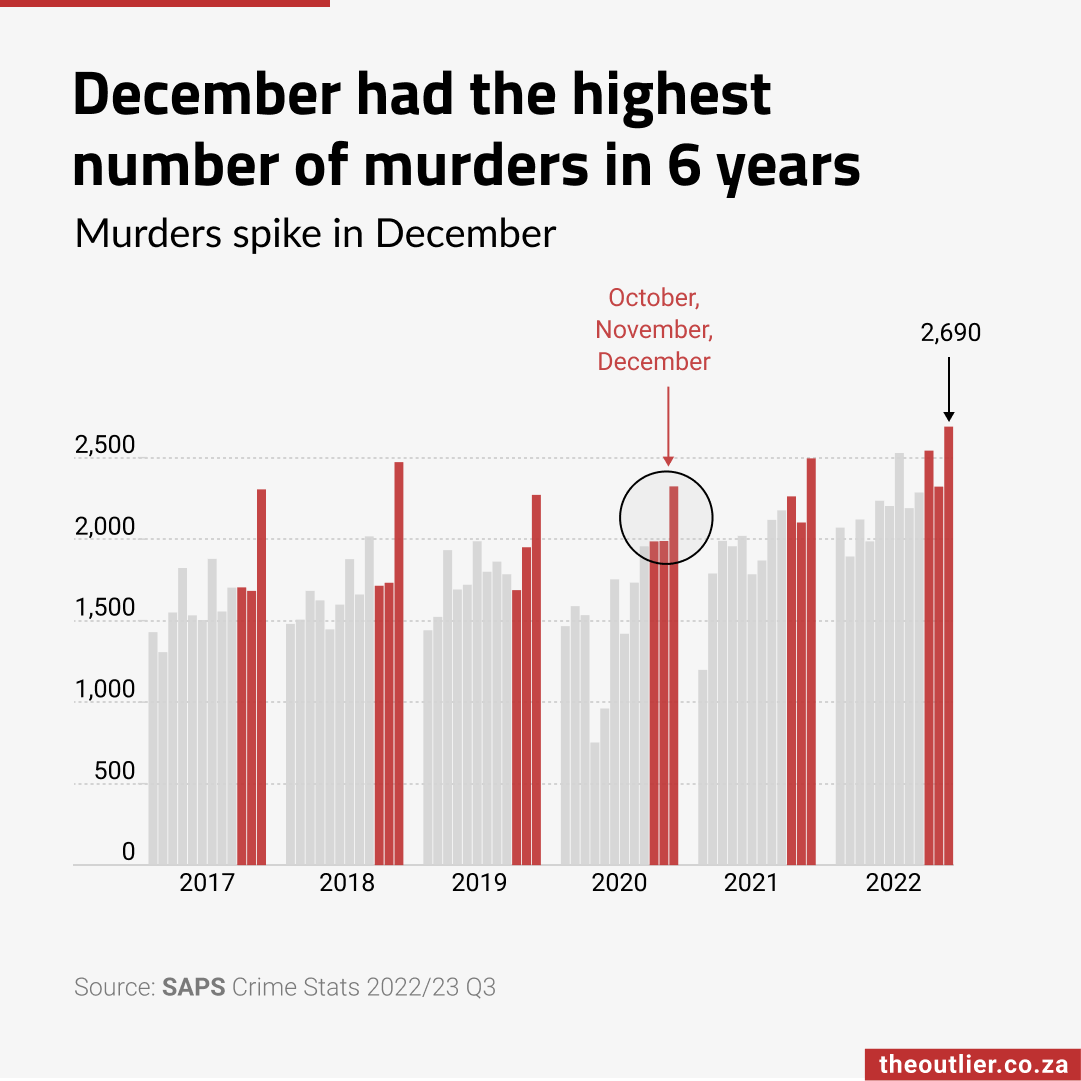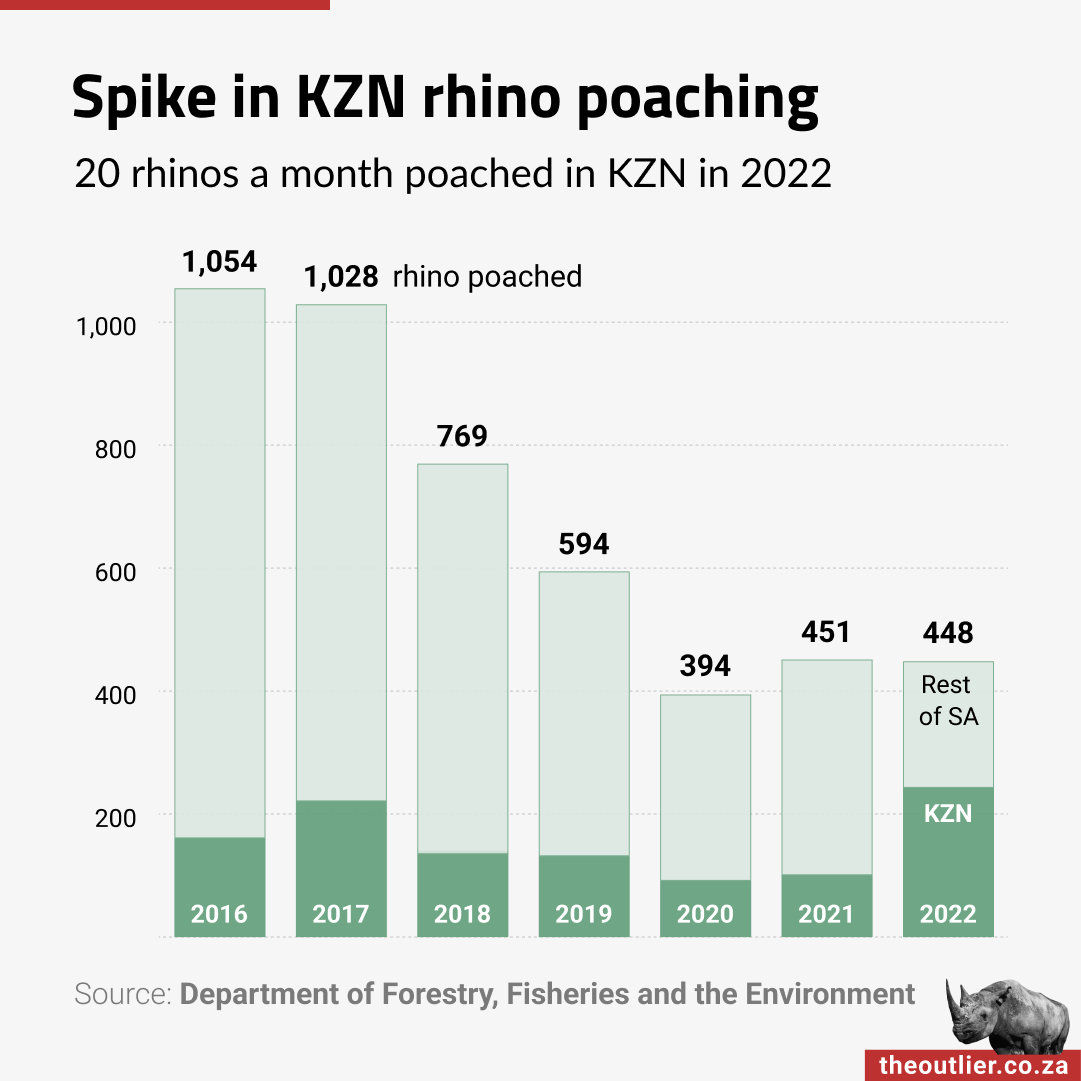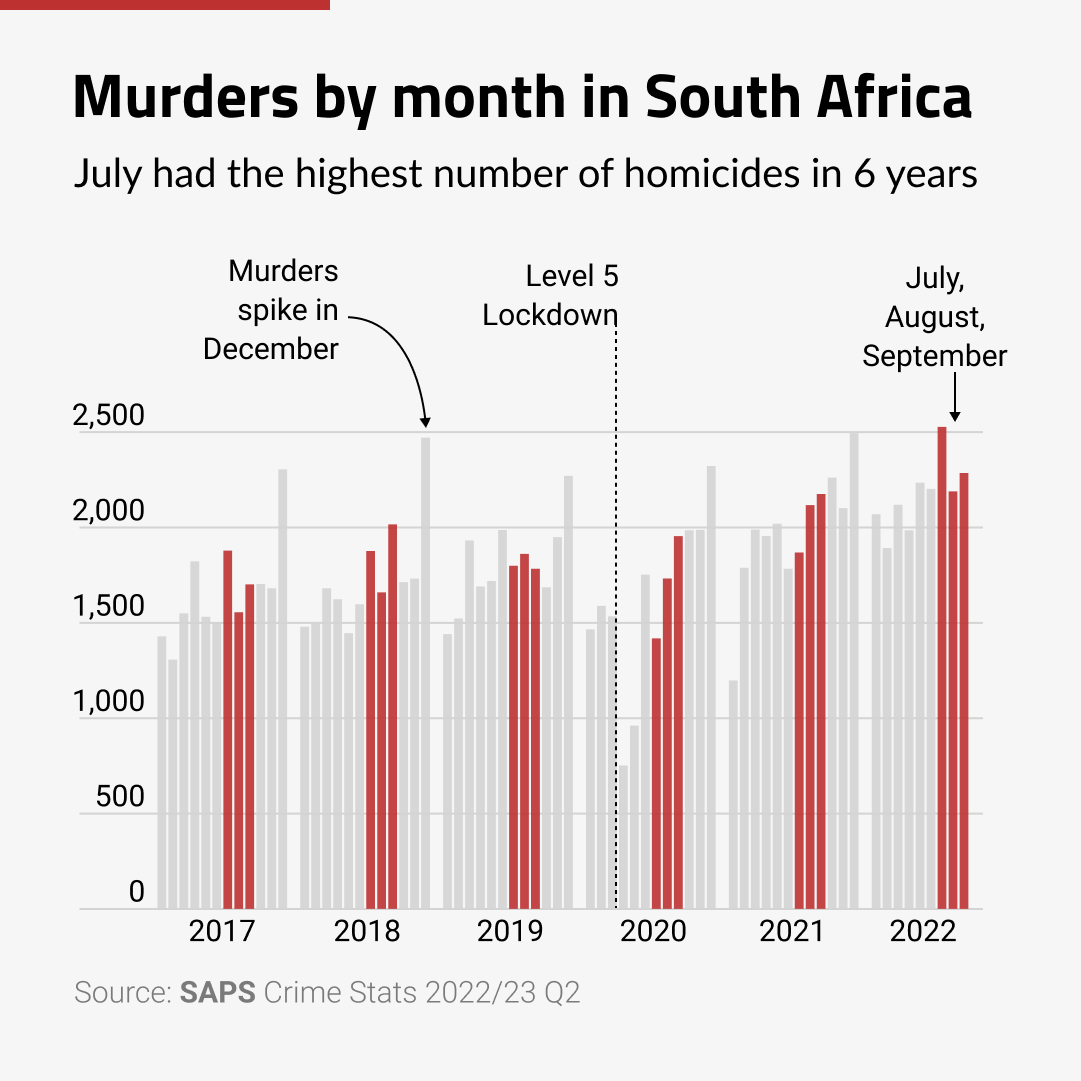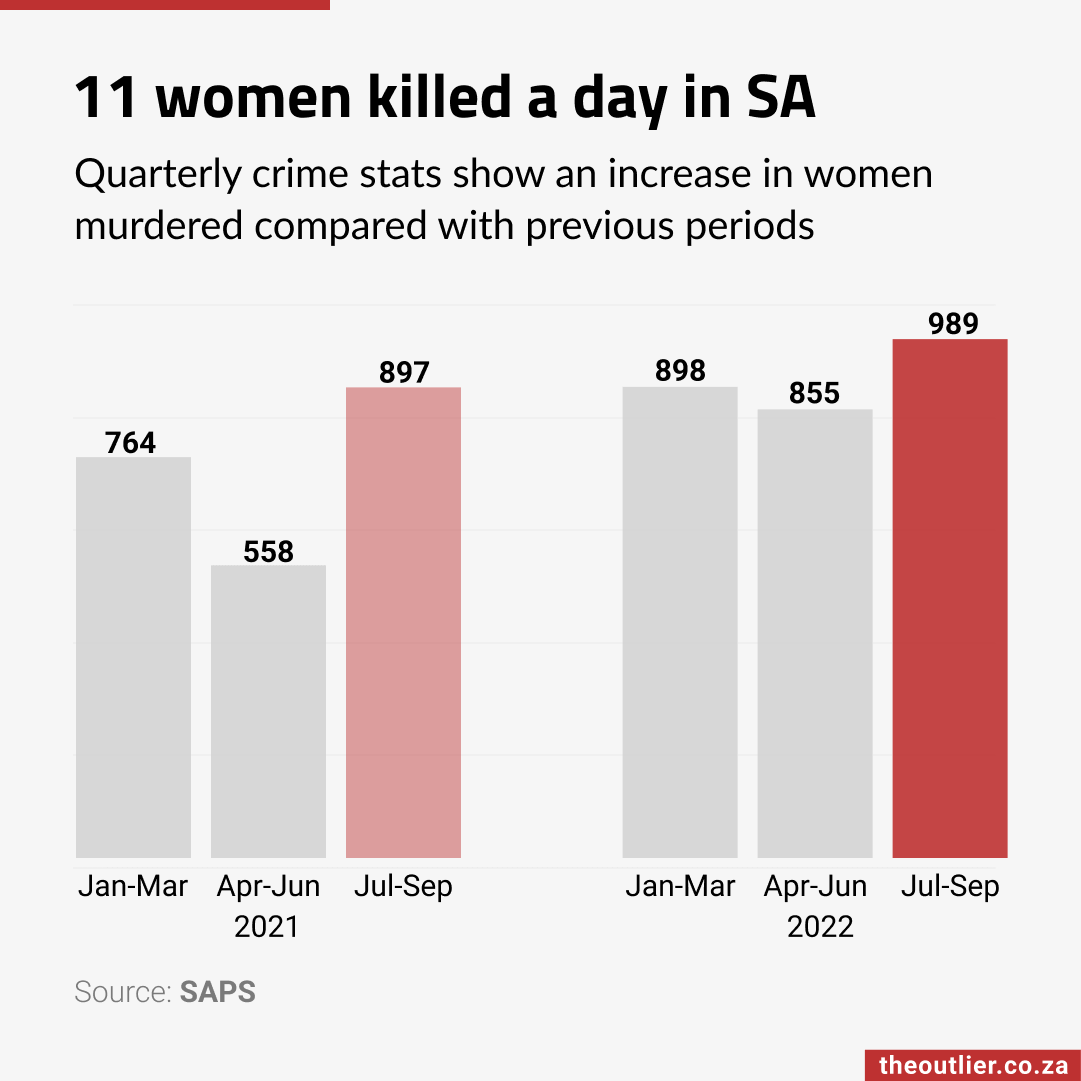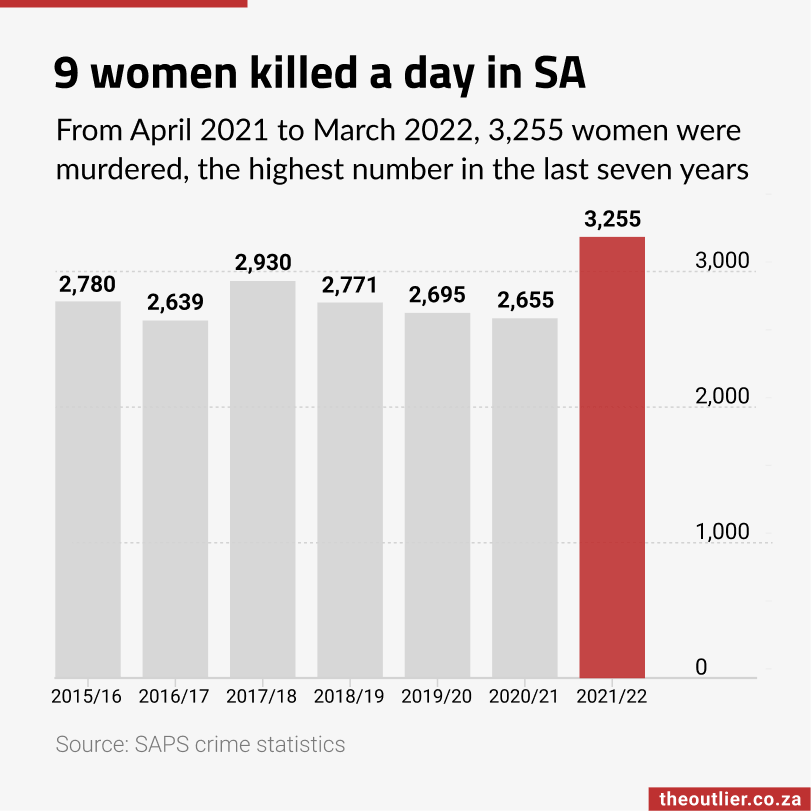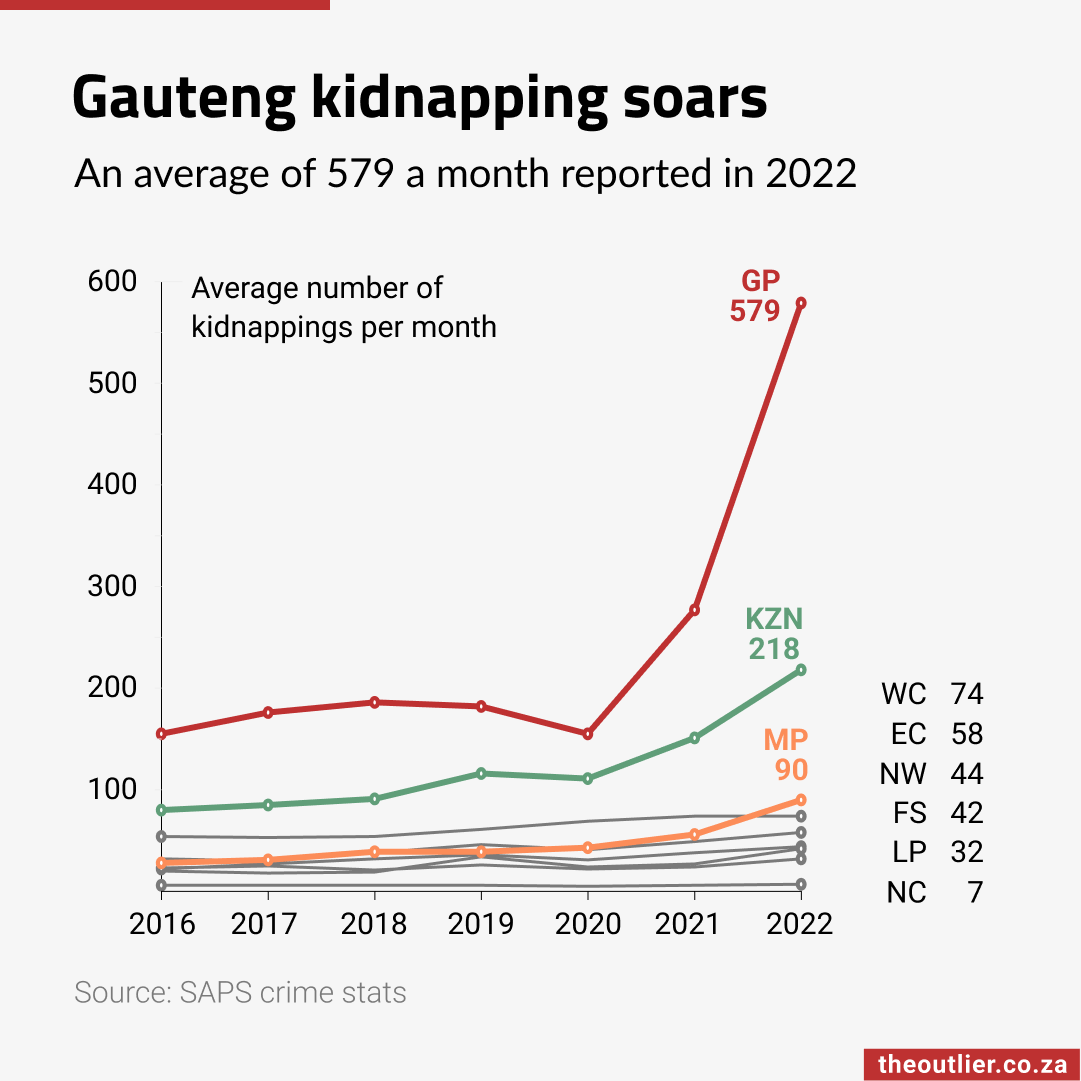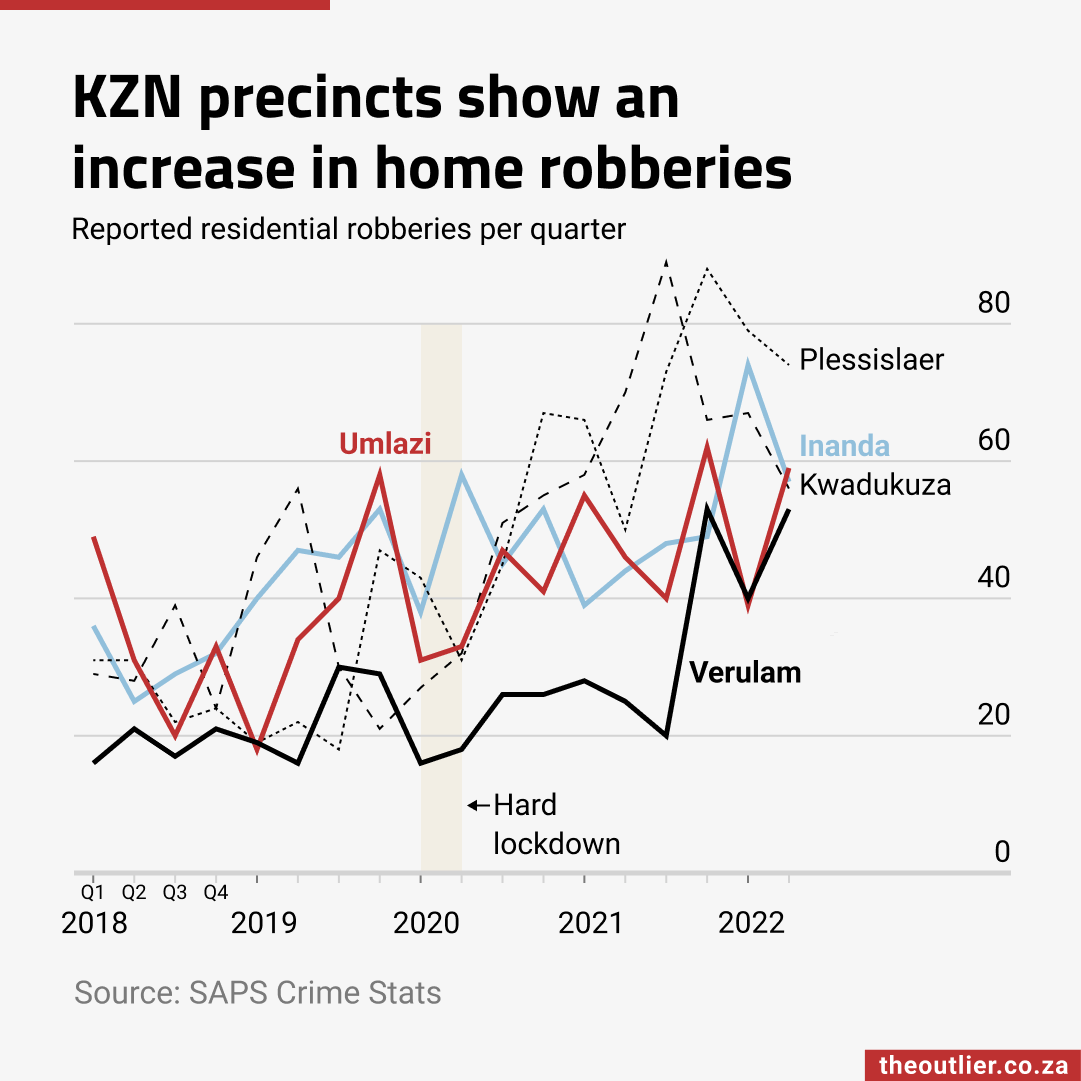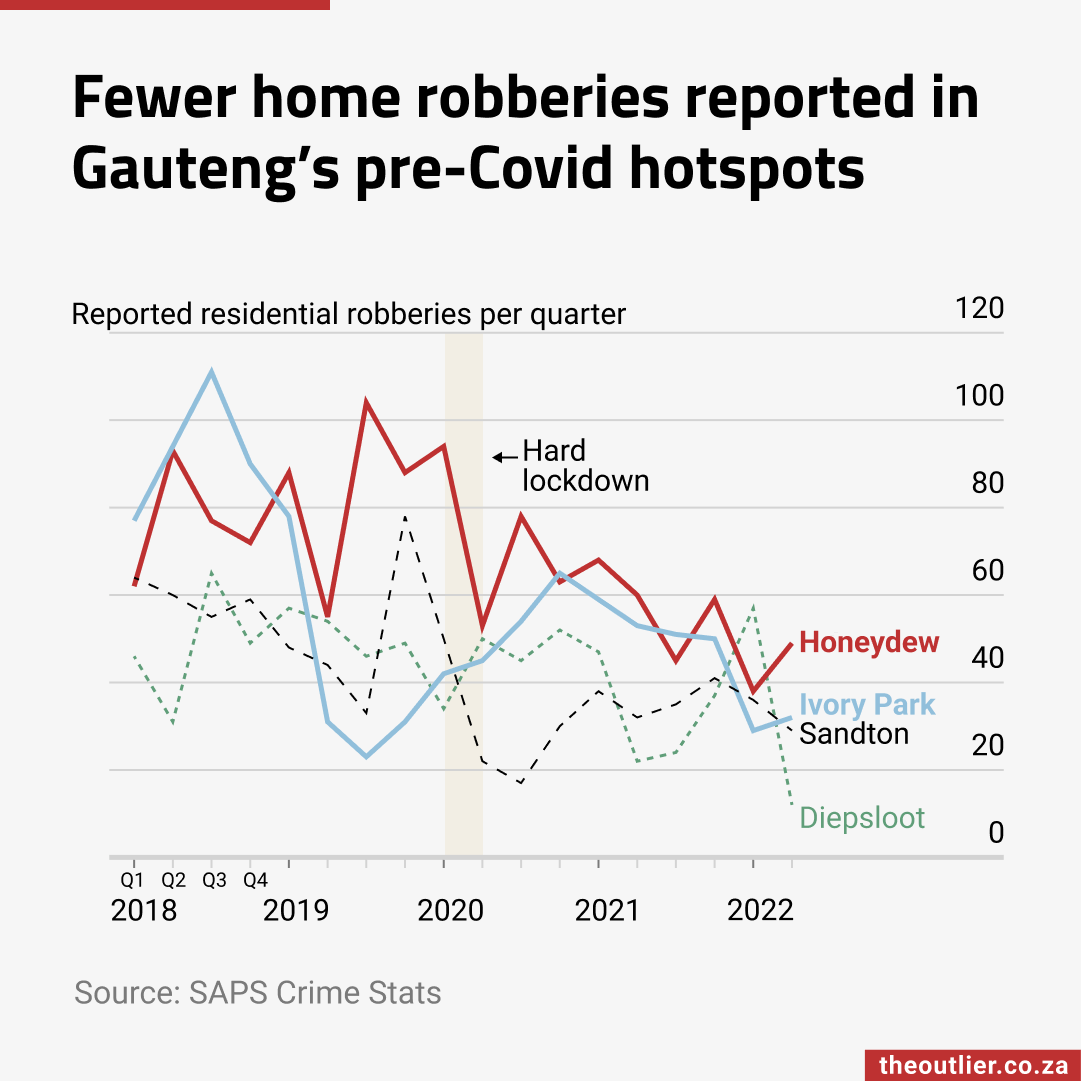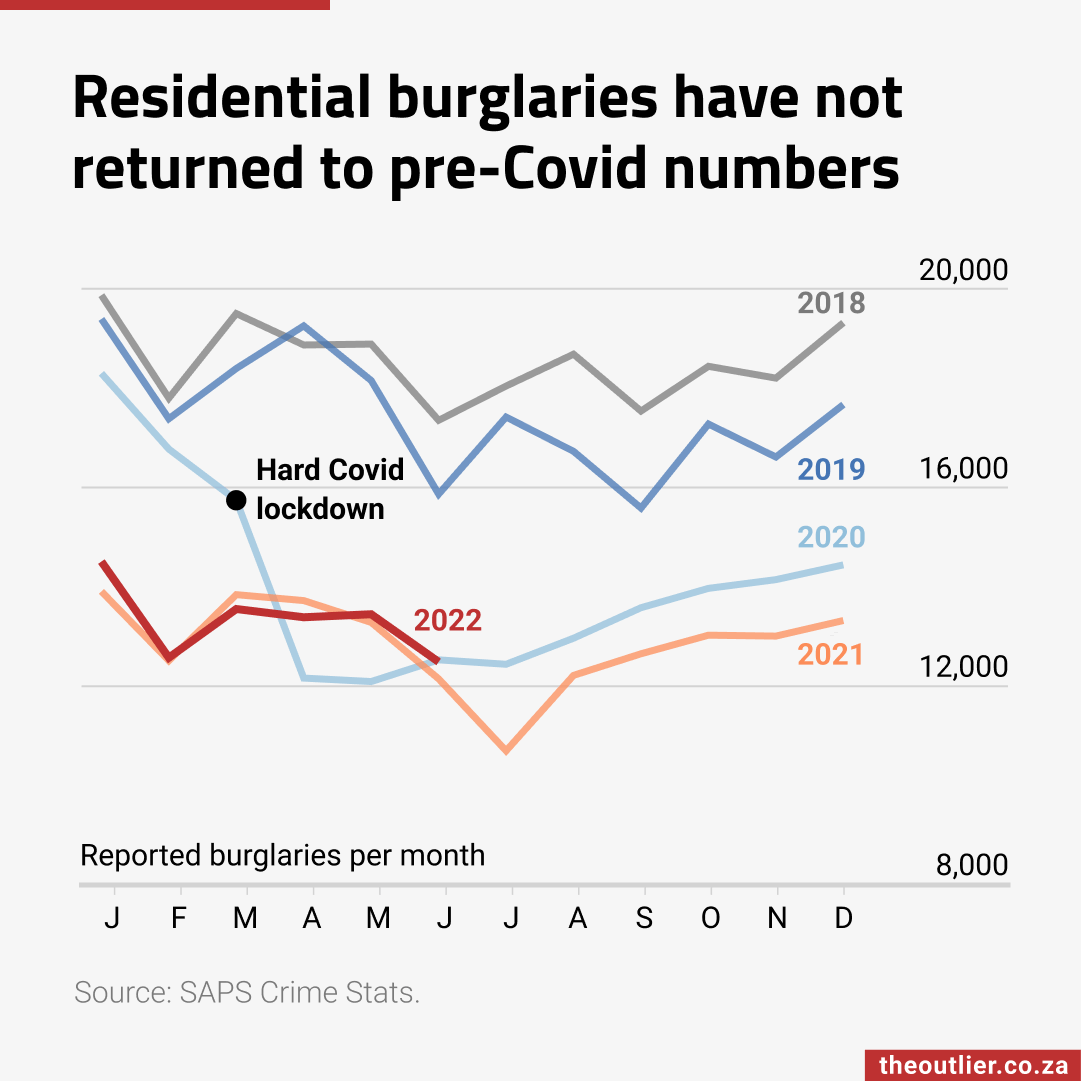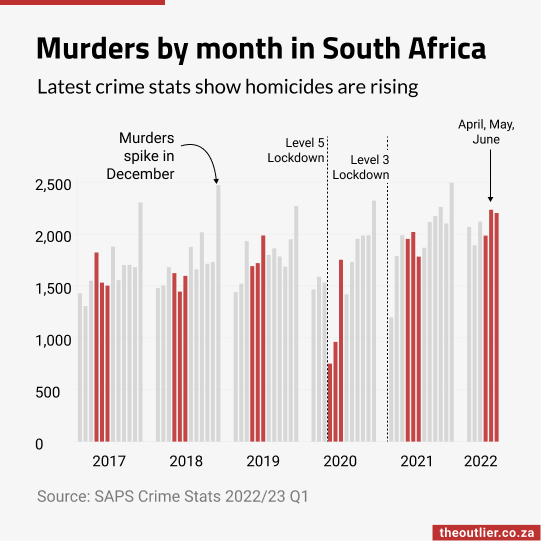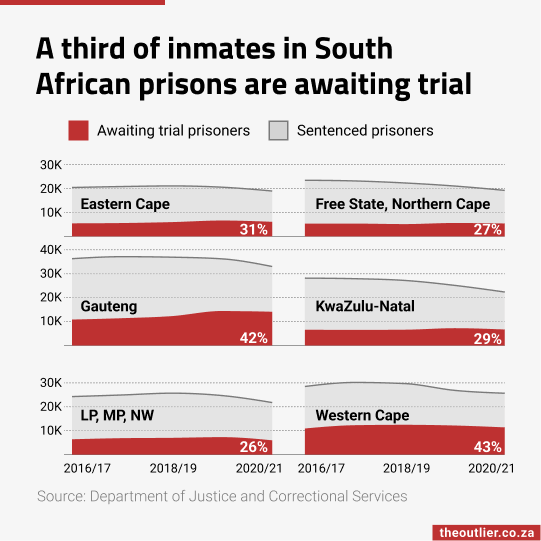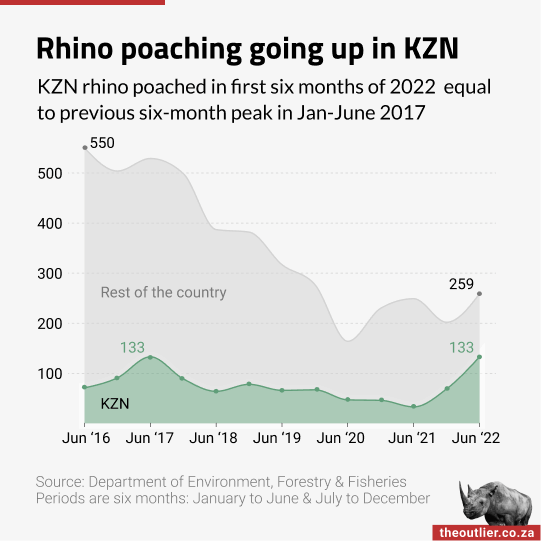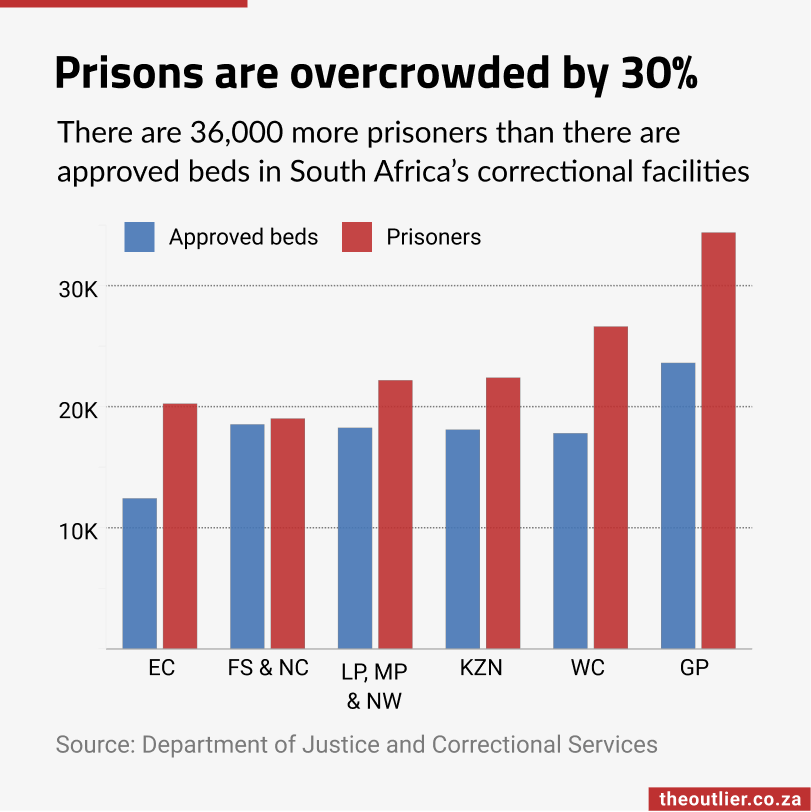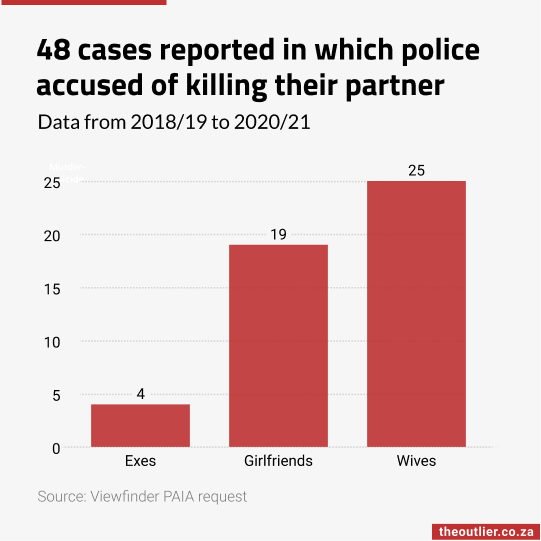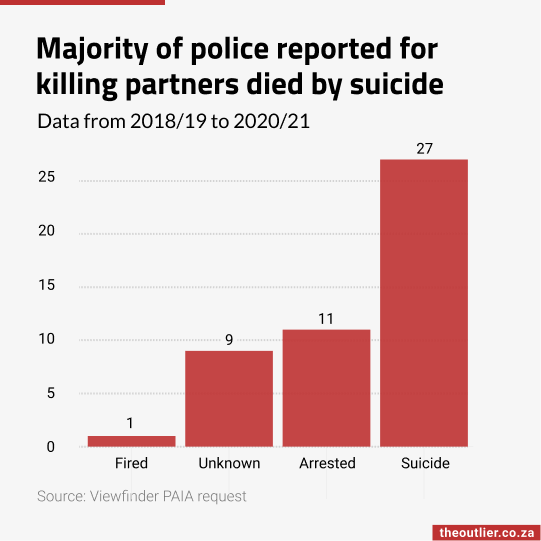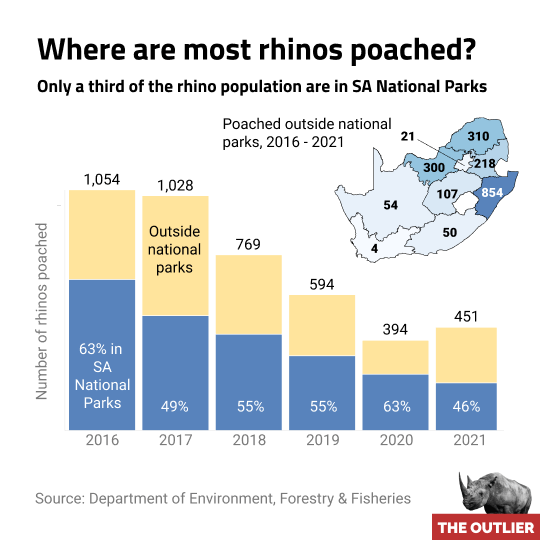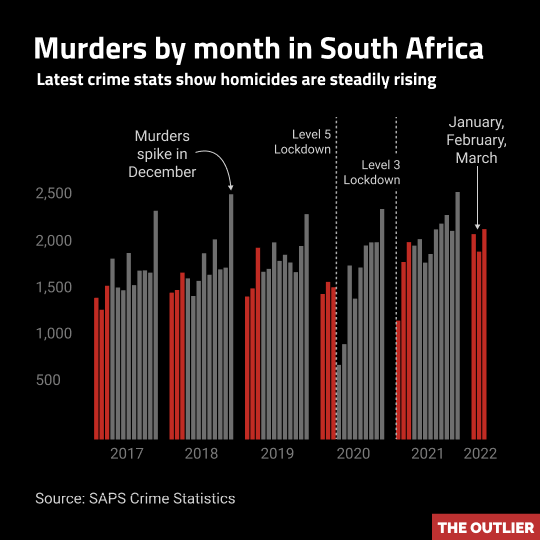
Over half a million people in South Africa fell victim to consumer fraud in the past year. It is a sharp rise from 385,000 in 2019/20, according to Statistics South Africa’s 2024/25 Governance, Public Safety and Justice Survey. Women make up just over half of the victims.
Consumer fraud refers to being cheated on the quality or quantity of goods or services, and includes scams such as R99 debit orders, 419 schemes, and dubious online shopping deals.
Yet only one in three victims reported the crime to the police. Others turned to different authorities (32%) or tried to resolve it themselves (31%).
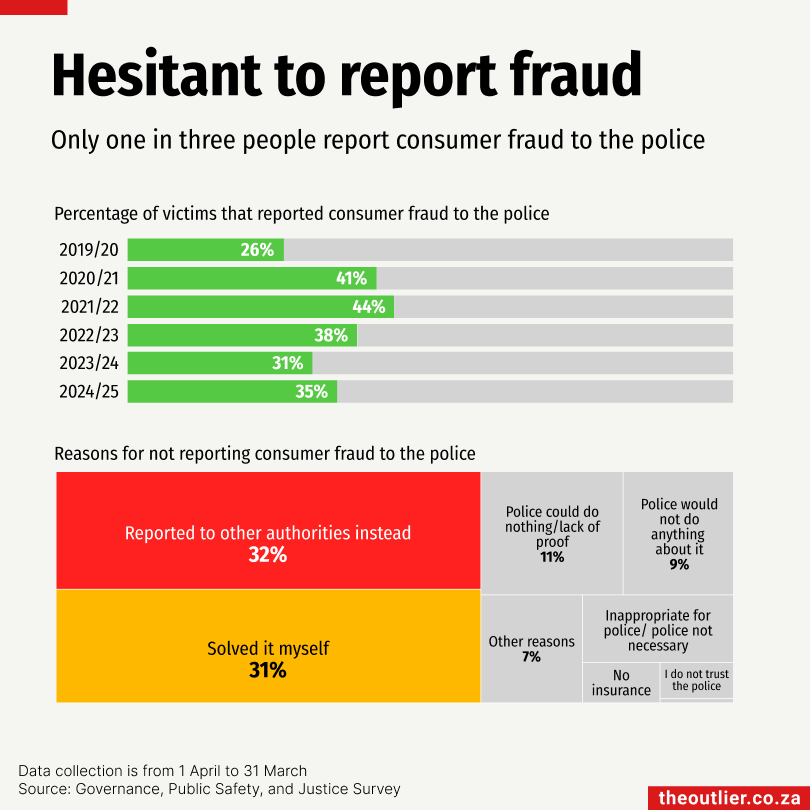
People are hesitant to report consumer fraud to the police, according to Statistics South Africa’s 2024/25 Governance, Public Safety and Justice Survey.
Over half a million people in South Africa fell victim to consumer fraud in the past year. That is a sharp rise from 385,000 in 2019/20.
But only one in three people reported these crimes to the police in 2024/25. It’s a decrease from the 44% who reported fraud in 2021/22.
Consumer fraud refers to being cheated on the quality or quantity of goods or services, and includes scams such as R99 debit orders, 419 schemes, and dubious online shopping deals.
Instead of reporting to the police, people have turned to different authorities (32%) or attempted to resolve the issue themselves (31%).

South Africa’s police service has more than 2,000 unfilled detective positions.
In a written response to Build One South Africa’s Mmusi Maimane, the minister of police, said that the Western Cape and KwaZulu-Natal were the worst off, reporting 902 and 639 vacancies, respectively.
The Eastern Cape was the only province where the number of filled detective posts exceeded the number funded, a rare surplus.
Without enough detectives, investigations stall, and justice is delayed. In March 2025, nearly half a million case dockets (499,873) were more than two years old, including 79,401 murder cases, according to a parliamentary response.
Adding to the problem is the fact that even when cases make it to court, only 12% result in a guilty verdict, according to criminologist Guy Lamb.

More than 200 corruption probes by the Special Investigating Unit (SIU) have been authorised by South African presidents in the past 11 years.
The SIU’s job is to recover government losses from financial crime. When there are serious allegations of corruption, malpractice and maladministration in state institutions, the presidency can authorise the unit to investigate with a presidential proclamation.
The presidency has issued a total of 300 presidential proclamations since 2001 and 55% of those were by Cyril Ramaphosa since he became president in February 2018.
The 2024/2025 financial year was particularly prolific with 49 proclamations issued.

The Special Investigating Unit is “one of South Africa’s most effective anti-corruption agencies”, says the Institute for Security Studies (ISS) in a policy brief titled The future of South Africa’s Special Investigating Unit.
The unit’s job is to recover government losses from financial crime. When there are serious allegations of corruption, malpractice and maladministration in state institutions, the presidency can authorise the unit to investigate with a presidential proclamation.
How effective are these investigations? “It is difficult to measure the effectiveness of anti-corruption agencies, and reputation is often used as an indication of effectiveness,” says the ISS.
But one measurable metric is the value of cash and assets recovered. Over the past five years, the SIU has recovered nearly R5-billion in assets. Another R19.5-billion worth of contracts were set aside because of SIU investigations.
The 2023/24 financial year was particularly successful, with R2.3-billion in assets recovered, most of which were from two major investigations into Transnet and the National Student Financial Aid Scheme.
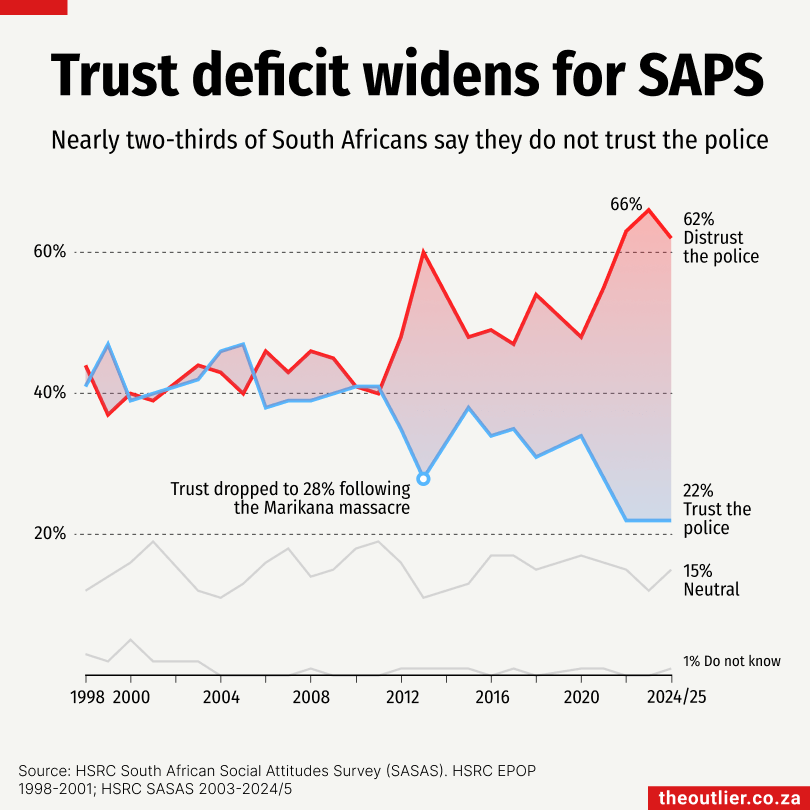
South Africans don’t trust the police. About one in five people surveyed by the Human Sciences Research Council (HSRC) earlier this year said they ‘trust’ or ‘strongly trust’ the police, but three in five said they ‘distrust’ the police.
Trust in the police has almost halved, from 41% of the people surveyed in 1998 to just 22% in 2024/25, according to an HSRC report, National and provincial trends: Trust in the police, 1998-2025.
The most recent survey results are the lowest recorded levels of trust in 27 years, said the HSRC.
The survey found that trust eroded when people felt they were treated unfairly or disrespected, or believed the police lacked impartiality, transparency, or effectiveness.
Why does this matter? The HSRC says, “The risk is that low and diminishing confidence in the police, if left unchecked, will also continue to negatively shape views of key elements of police legitimacy.”
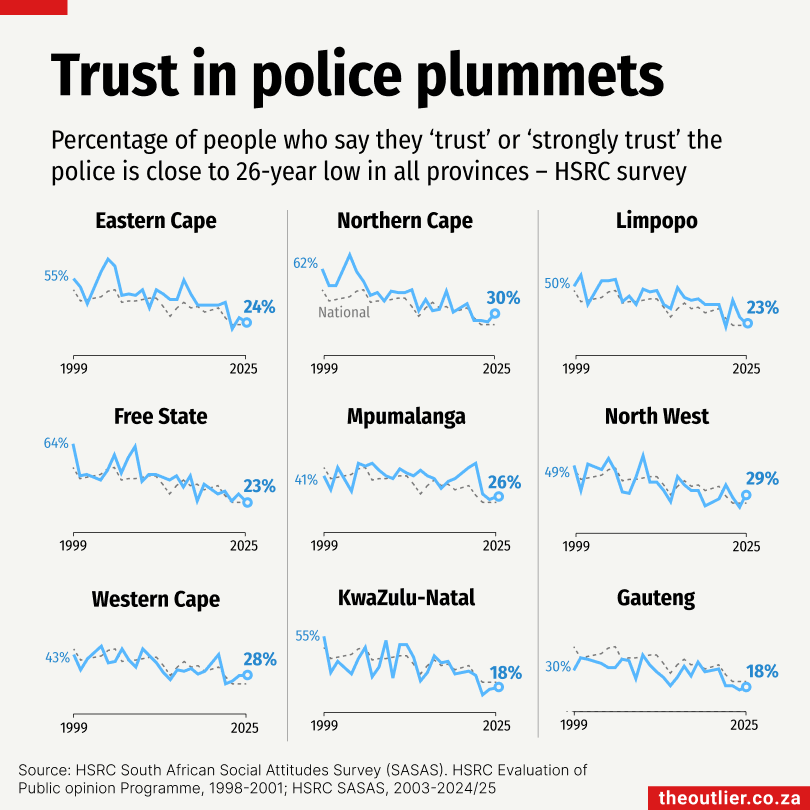
Trust in the police has dropped in every province of South Africa.
There was a time when more than 60% of people in the Northern Cape, Free State, and Eastern Cape said they trusted the police. But in a survey conducted in early 2025, not a single province recorded trust levels above 30%.
Nationally, trust in the police has nearly halved, from 41% in 1998 to just 22% in 2024/25, according to the Human Sciences Research Council (HSRC) report National and provincial trends: Trust in the police, 1998-2025.
“While provincial levels and trajectories have varied, the trend points to a deepening legitimacy crisis for SAPS across the country,” the HSRC says. “Historically higher-trust provinces are converging downward towards the levels of deep scepticism observed in Gauteng and KwaZulu-Natal.”
“The risk is that low and diminishing confidence in the police, if left unchecked, will also continue to negatively shape views of key elements of police legitimacy,” warns the HSRC.

Alcohol use has previously been linked to an increase in femicide, but research on this in lower- and middle-income countries has been relatively scarce. A 2025 study using South African data from the Covid-19 lockdowns offers new insight.
During periods when alcohol sales were completely banned, the number of women killed – by both intimate partners and non-partners – fell by 63% compared to periods without restrictions. Researchers compared national data from 2017 with the first year of the pandemic (2020–21), during which varying lockdown restrictions, including bans on alcohol, were enforced.
The pattern of fewer reported femicide cases was most obvious in the early stages of the Covid restrictions, between April and May 2020.
From the report: “The findings support alcohol use as a significant risk factor for femicide and underline the need for alcohol harm reduction policies as part of gender-based violence prevention strategies.”

Most murders do not happen on South African farms – despite claims by US President Donald Trump that white farmers are under attack – a narrative not supported by the country’s crime data.
In the last quarter of 2024, more than 6,000 murders were recorded nationwide, according to official police statistics. Just 96 took place on farms, plots, and small holdings – a broad category that likely includes farm workers and nearby residents, not just landowners or “white farmers.” In contrast, 244 murders took place in pubs, taverns, and bottle stores. Public places saw the highest number of murders (3,821), followed by private homes (1,966).
The majority of South Africa’s murder victims are young Black men. As Gareth Newham of the Institute for Security Studies explains,“Murder victimisation is far more correlated to class, gender and location than race.”
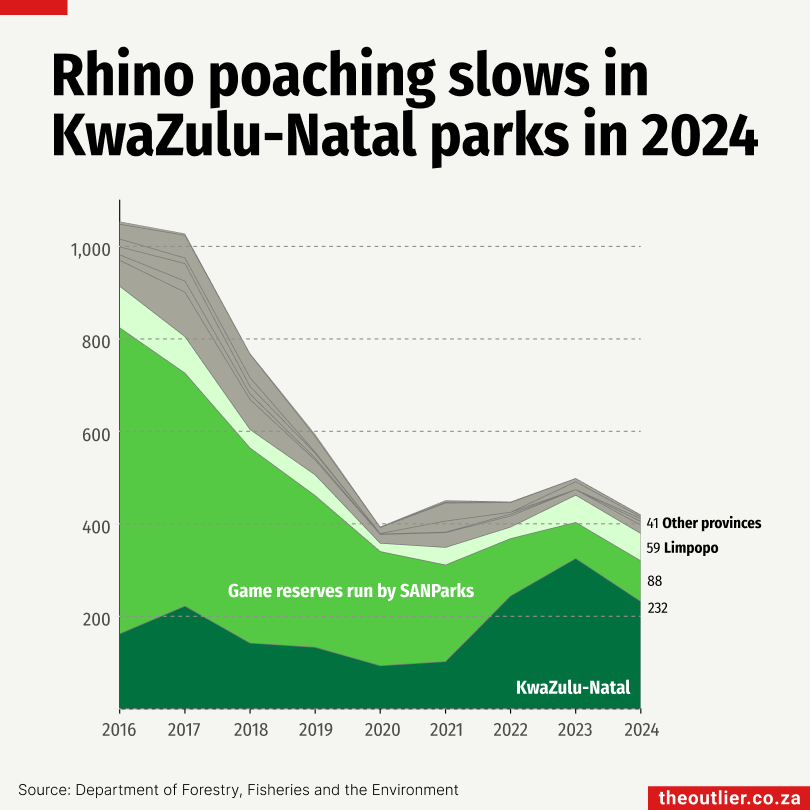
A programme to dehorn rhinos in KwaZulu-Natal’s Hluhlwe-iMfolozi Park in 2024 appears to be paying off for Ezemvelo KZN Wildlife. The province lost 325 rhinos to poachers in 2023, but thanks to the dehorning programme, the number killed dropped by nearly 30% in 2024.
The Kruger National Park, which is run by South African National Parks (SANParks), used to be the epicentre of rhino poaching in the country, but in 2022, that shifted to the game reserves in KwaZulu-Natal.
South Africa lost 420 rhinos to poaching in 2024 — less than the 499 killed in 2023.
Minister of forestry, fisheries and the environment Dion George said four out of five rhinos killed were on state properties and the rest were on privately owned parks, reserves or farms.Get the data used in this chart on DataDesk
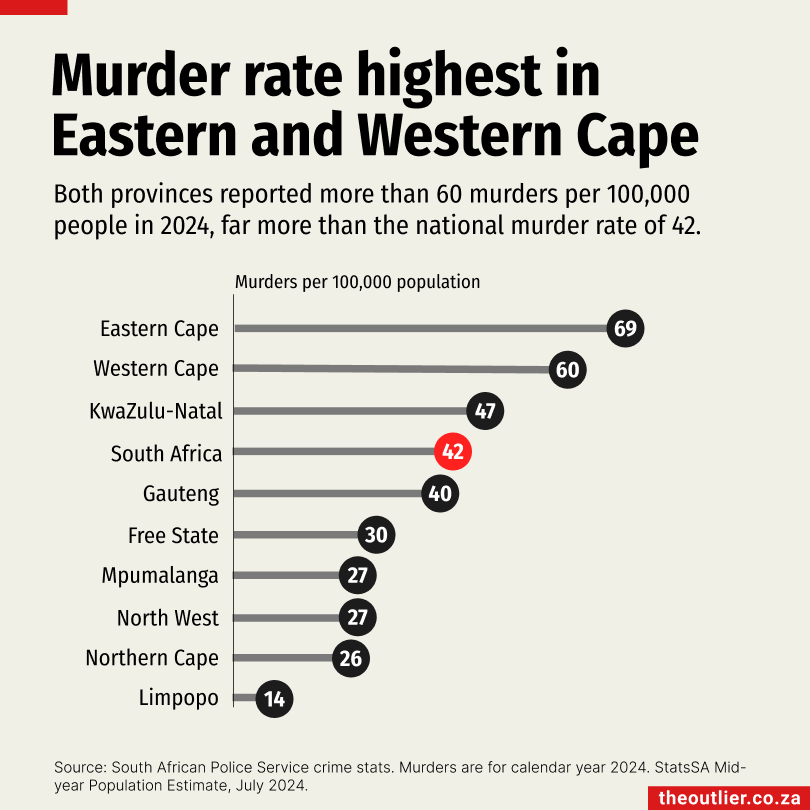
In 2024, there were 26,232 murders reported to the police – an average of 72 murders a day, according to crime statistics released by the South African police service. This is an improvement on the past two years, when more than 27,000 murders were reported and the daily average was 74 murders a day.
The four most populous provinces reported the highest number of murders in 2024: Gauteng (6,314 murders), KwaZulu-Natal (5,835), Eastern Cape (4,943) and Western Cape (4,511). Gauteng averaged 17 murders a day and KwaZulu-Natal average 16 a day.
The Eastern Cape and Western Cape had the highest murder rate per capita. In 2024, the murder rate in the Eastern Cape was 69 murders per 100,000 people, the Western Cape’s was 60 per 100,000. Both are much higher than the national murder rate of 42 per 100,000 people.
The latest police crime stats were for the third quarter of 2025. This period covers October to December 2024. The Outlier has calculated the murder numbers for 2024 (January to December) from previous quarterly crime stats released.
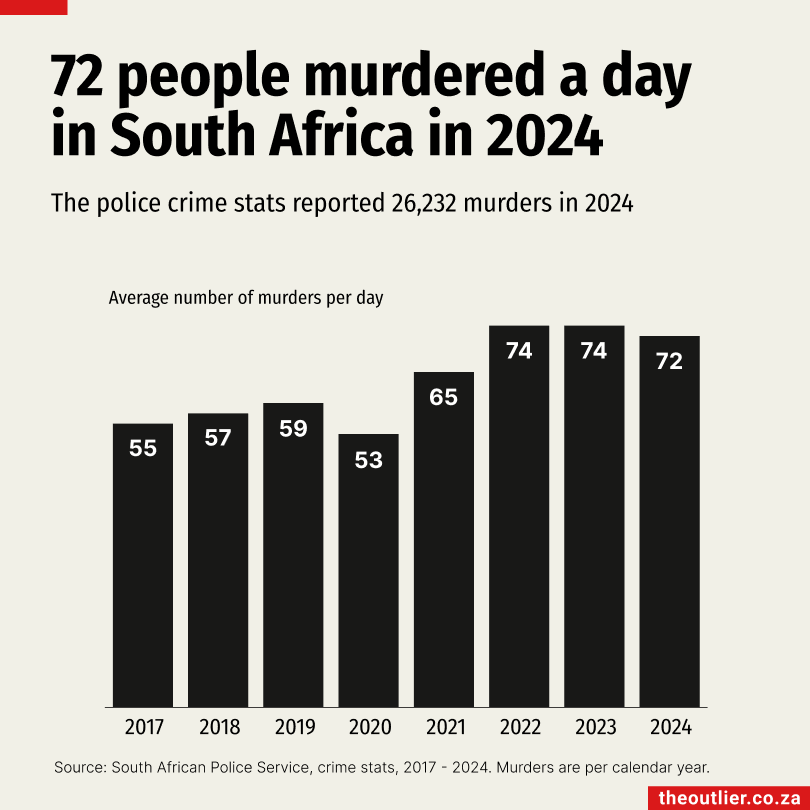
In 2024, there were 26,232 murders reported to the police – an average of 72 murders a day, according to crime statistics released by the South African police service. This is an improvement on the past two years, when more than 27,000 murders were reported and the daily average was 74 murders a day.
The four most populous provinces reported the highest number of murders in 2024: Gauteng (6,314 murders), KwaZulu-Natal (5,835), Eastern Cape (4,943) and Western Cape (4,511). Gauteng averaged 17 murders a day and KwaZulu-Natal average 16 a day.
The Eastern Cape and Western Cape had the highest murder rate per capita. In 2024, the murder rate in the Eastern Cape was 69 murders per 100,000 people, the Western Cape’s was 60 per 100,000. Both are much higher than the national murder rate of 42 per 100,000 people.
The latest police crime stats were for the third quarter of 2025. This period covers October to December 2024. The Outlier has calculated the murder numbers for 2024 (January to December) from previous quarterly crime stats released.
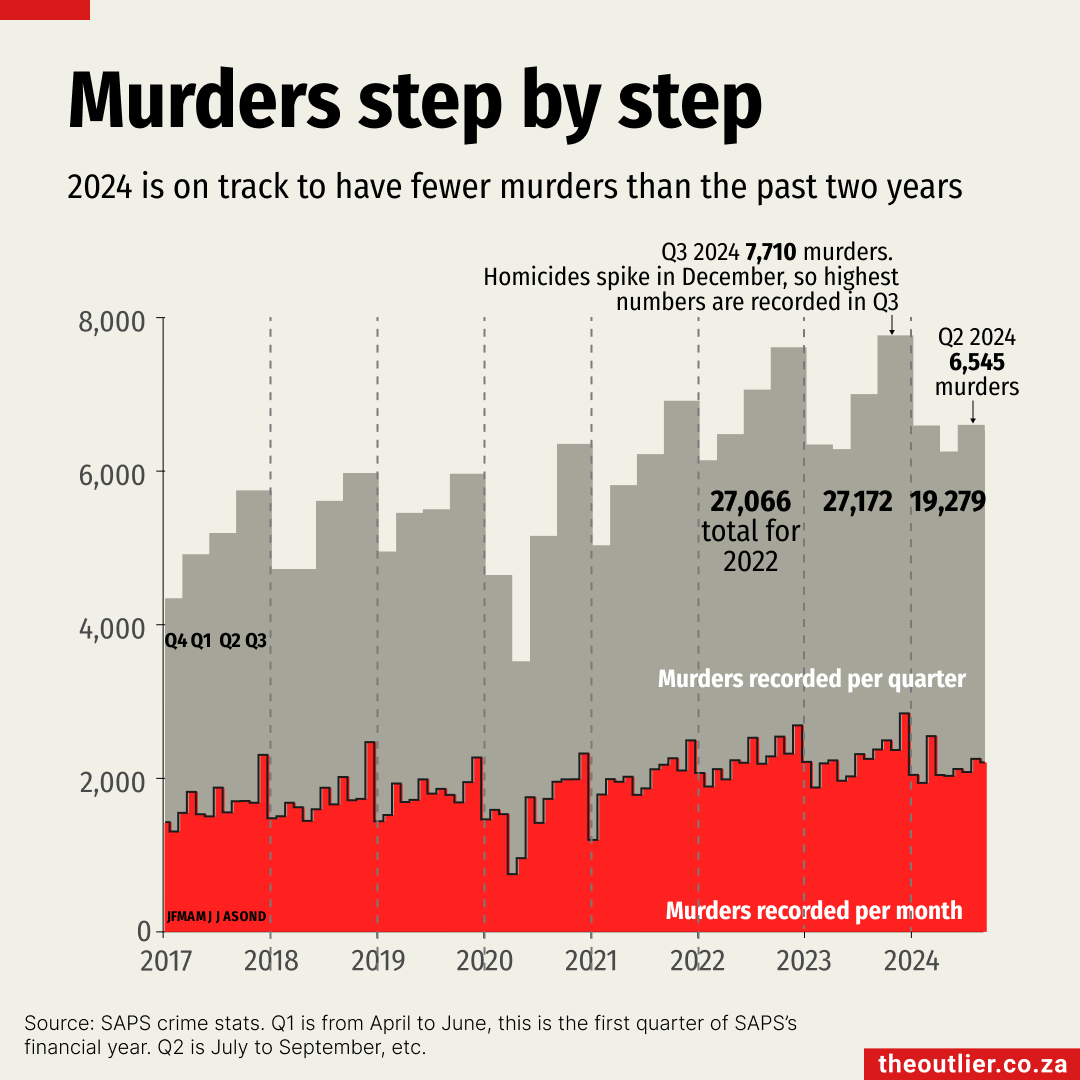
- Murders reported between July-September are 2024’s highest
- But they are 5.8% lower than for the same period last year
- This year could have the lowest murder count since 2021
A 5.8% drop in murders reported to the SAPS was announced this week. While we all need good news, it’s helpful to take a longer-term view.
The crime stats follow the SAPS’s financial year, which starts in April. This means Q1 covers April to June, while Q2 is July to September. Change is tracked by comparing the same period over two concurrent years. So in Q2 2024, murders decreased by 5.8% compared with Q2 last year.
This quarter’s murder stats are the highest this year: January to March had 6,536 murders, April to June had 6,198, and July to September had 6,545. But this quarter has recorded the lowest Q2 numbers since 2021: 6,945 murders in 2023, 7,004 in 2022 and 6,163 in 2021.
So far this year to September, 19,279 murders were reported. Unless December is particularly violent, we are on track to record the first decrease in murders since Covid.
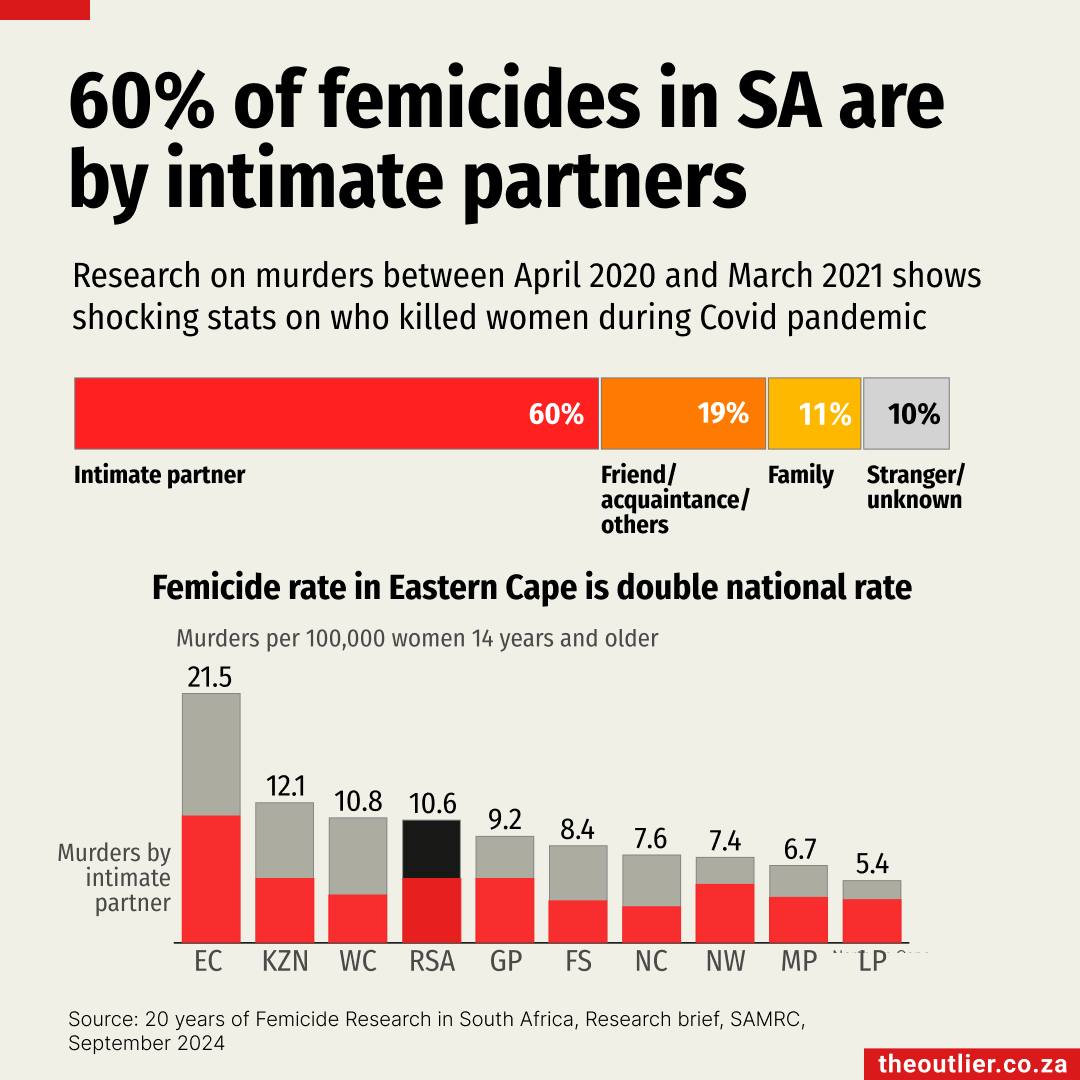
- 3 women are killed a day in SA by current or former intimate partners
- Femicide rate in Eastern Cape is double the national average
- Fewer than 1 in 5 intimate-partner femicide cases result in conviction
Three women are killed a day by their current or ex husbands, boyfriends, partners or rejected would-be lovers, research by the Gender and Health Research Unit of the SA Medical Research Council found.
The unit has been studying femicide – the murder of women – for the past 20 years. Its latest study was carried out during the first year of Covid, from April 2020 to March 2021.
Although the SAMRC’s estimate of the number of women murdered is lower than that reported by the SA Police Service for the same period, the study gives insight into the perpetrators in a way the police data does not.
The study estimates femicides as a proportion of the female population. In SA, the femicide rate is 10.6 per 100,000 women. In the Eastern Cape, it is double that (21.5).
One in three of the women were killed by a firearm. One in six had evidence of sexual violence. Fewer than one in five of the intimate-partner femicide cases resulted in convictions.
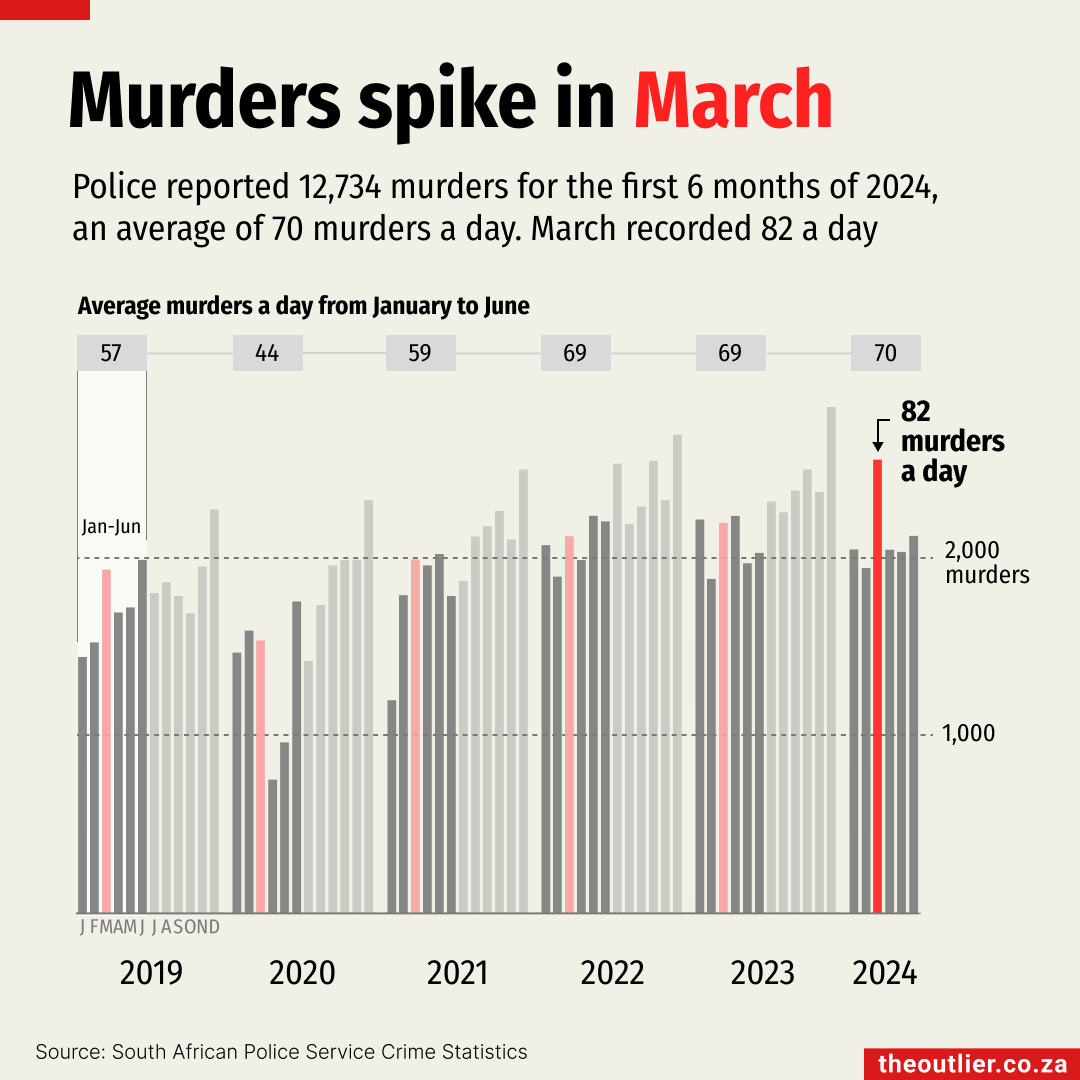
- Murders in South Africa spiked in March, averaging 82 deaths a day
- For the past six months, murders averaged 70 a day
- In first half of 2022 and 2023, murders averaged 69 a day
There was a spike in the number of murders reported by the SA Police Service in March, when 2,550 people were killed, or an average of 82 a day.
According to the latest data from the Saps, one in every five of the 12,734 murders reported in the first half of 2024 were in March. The average number a day for the six-month period is 70, so March is an outlier.
For the past two years, reported murders in the first half of the year averaged 69 a day.
It’s not clear from the provincial data if the March murders were localised because, as usual, almost half (46%) of the murders reported that month were in Gauteng and KwaZulu-Natal. None of the other provinces showed a notable increase.
The first six months of the year are generally not peak periods for murder. Interpersonal violence typically spikes over the festive season when people spend more time together.
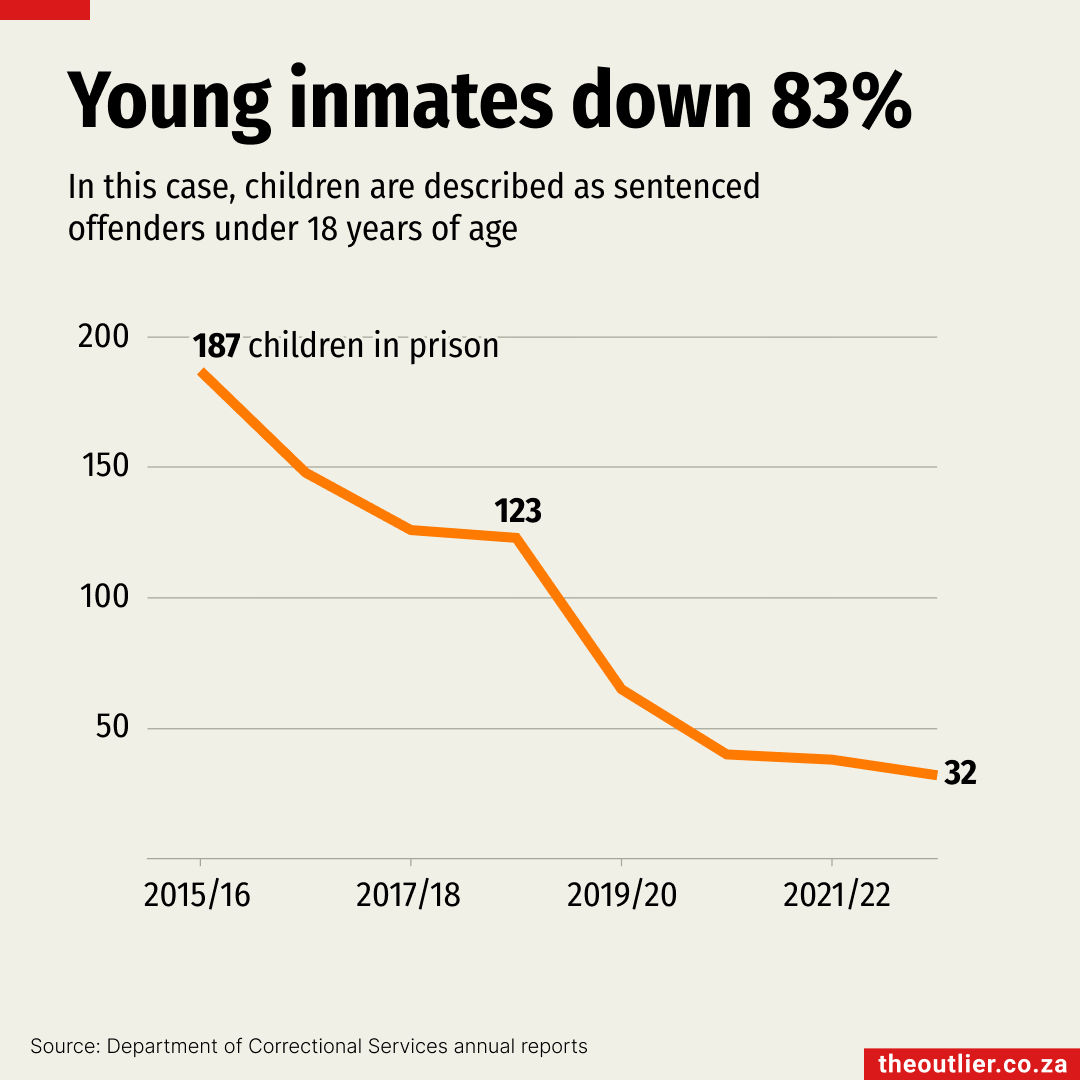
- 32 children in prison in 2022/23 versus 187 in 2015/16
- In SA prisons, children are described as under 18 years
- Just one young girl was in prison in 2022/23
The number of young inmates in South Africa’s prisons – those under the age of 18 – has dropped by about 83% since 2015/16, according to data from the department of correctional services.In August 2022, the age of criminal capacity was raised from 10 years of age to 12. The Child Justice Act means that anyone under 12 cannot be arrested and must be referred to a probation officer instead.Last year, there were 32 children in prison. That’s a six-fold decrease in comparison with the 187 children in prison seven years earlier. Of the young prisoners, just one was a girl.Meanwhile, the number of remand detainees, children in prison while awaiting trial, has increased. In 2021/22, there were 47 and by 2022/23 that had increased to 65.Sentenced youngsters are placed in secure care centres for children managed by the department of social development.
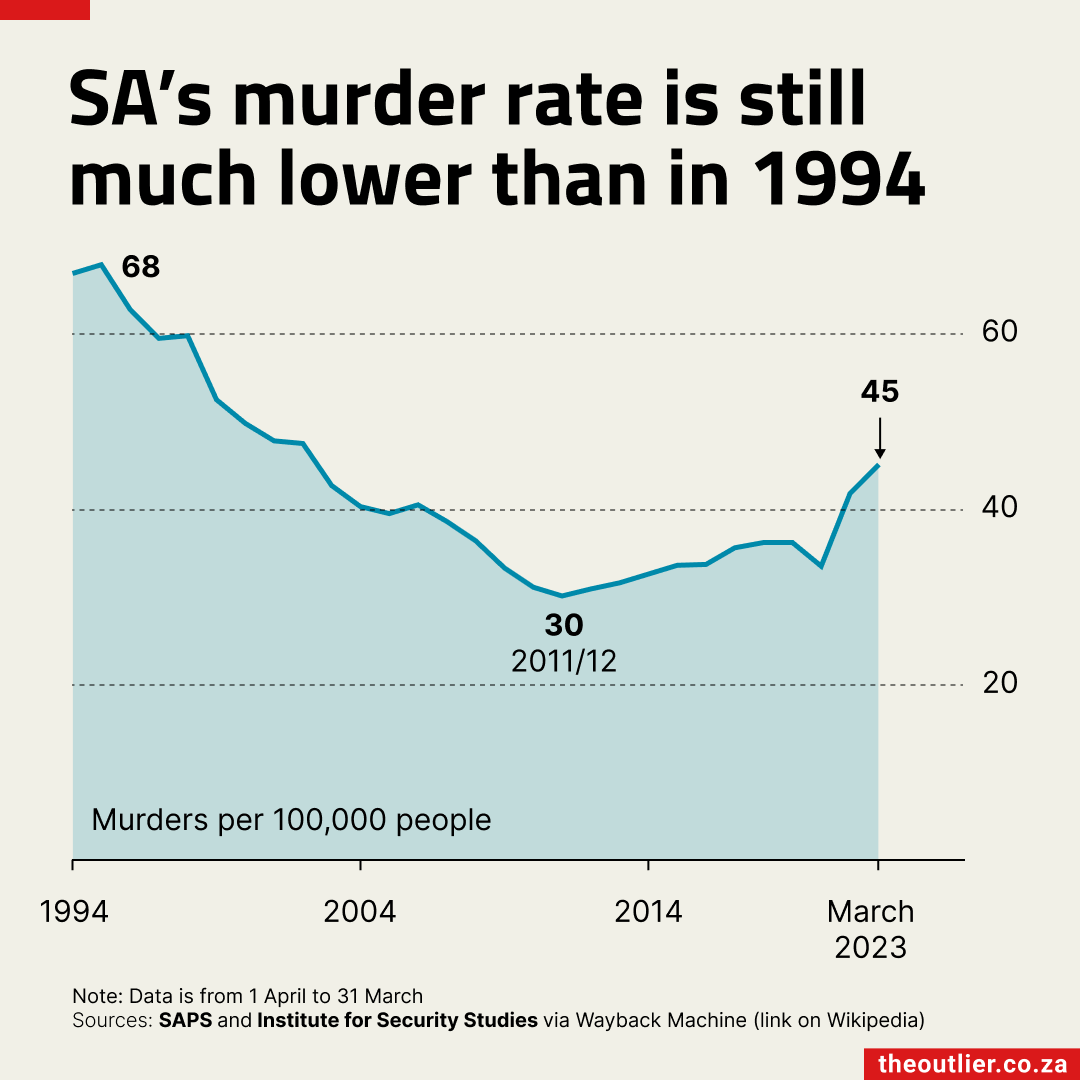
- Despite recent upturn, SA’s murder rate still lower than 1994
- Risk of being killed has dropped one-third in 30 years
- Sharp increase in violent crime recorded after 2020
Since the transition to democracy in South Africa, the murder rate has dropped by one third. Last year, the risk of being murdered was 45 murders per 100,000 people. Thirty years ago, it was 68 per 100,000.
Although the rate has fallen, the number of people being murdered is still high. Between April 2022 and March 2023, almost 27,500 people were killed, according to data from the SA Police Service. This is an average of 75 murders a day.
The lowest murder rate in the past three decades was recorded in 2011/2, when it was 30 per 100,000 people. The rate remained in the 30s until a lockdown-related dip in 2020, after which it has taken a steep turn up again.
There are complex factors for the high rate, say researchers, including tightened economic challenges, a drop in police numbers, increased access to firearms as well as a rise in organised crime.
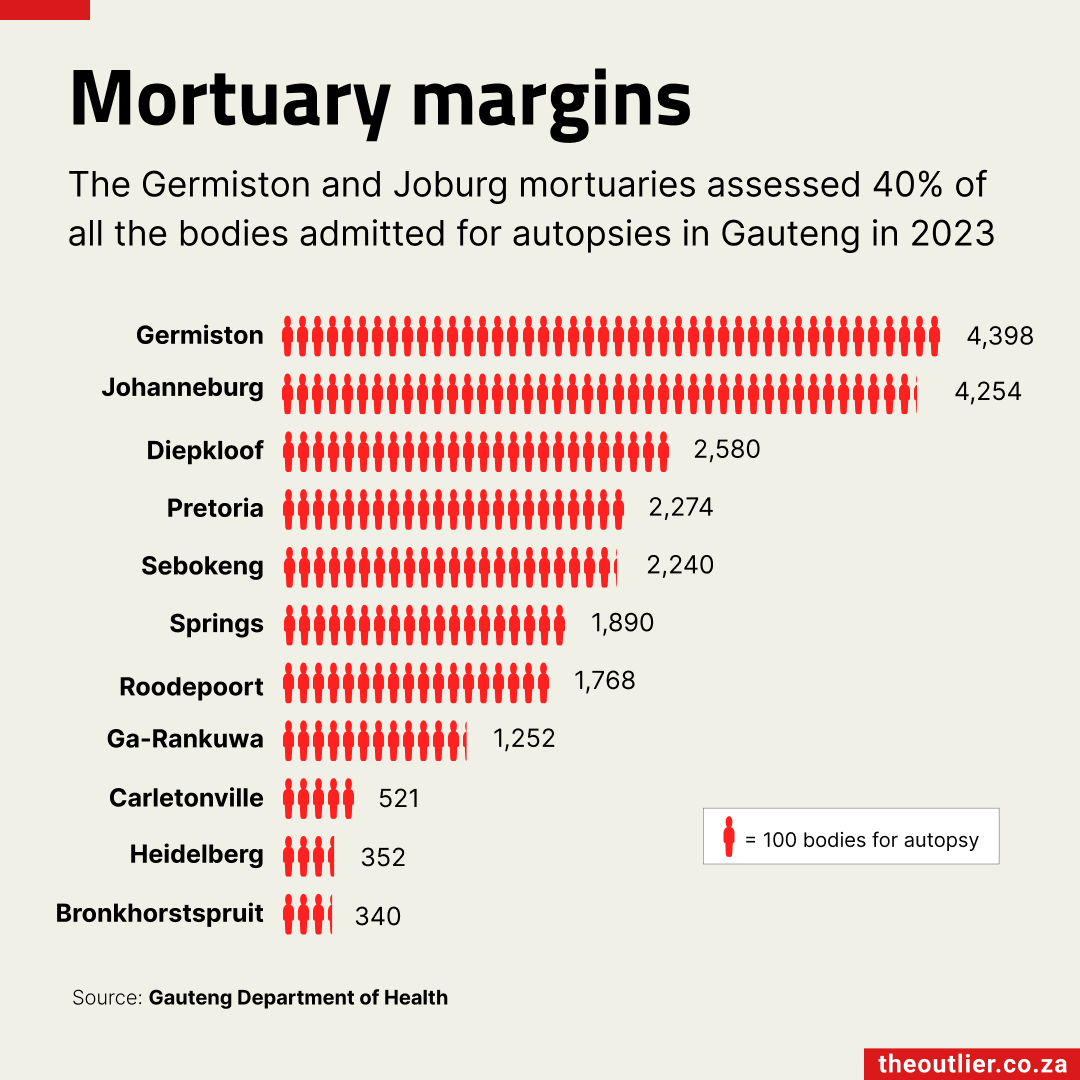
- SA’s murder rate is outpacing number of experts who do autopsies
- Shortage can affect quality of evidence and trial outcomes
- Gauteng has 16 forensic pathologists, KwaZulu-Natal has 2
The number of annual murders in South Africa has risen 36% since 2017, but the number of experts qualified to carry out autopsies has remained relatively static with about 50 forensic pathologists working for the state in 2023.
Solving crimes is more difficult without enough forensic experts to analyse the evidence. Forensic pathologist Prof Ryan Blumenthal says the shortage can delay court cases and compromise legal proceedings. ‘Examinations may be rushed due to increased workload [which] might mean evidence is not as reliable, affecting trial outcomes.’
Gauteng and the Western Cape have 16 forensic pathologists each, whereas most other provinces only have 1 or 2. KwaZulu-Natal, SA’s second-most populous province, has 2 forensic pathologists.
In the US, official guidelines recommend that forensic pathologists perform no more than 250 autopsies annually. SA does not have similar standards in place.
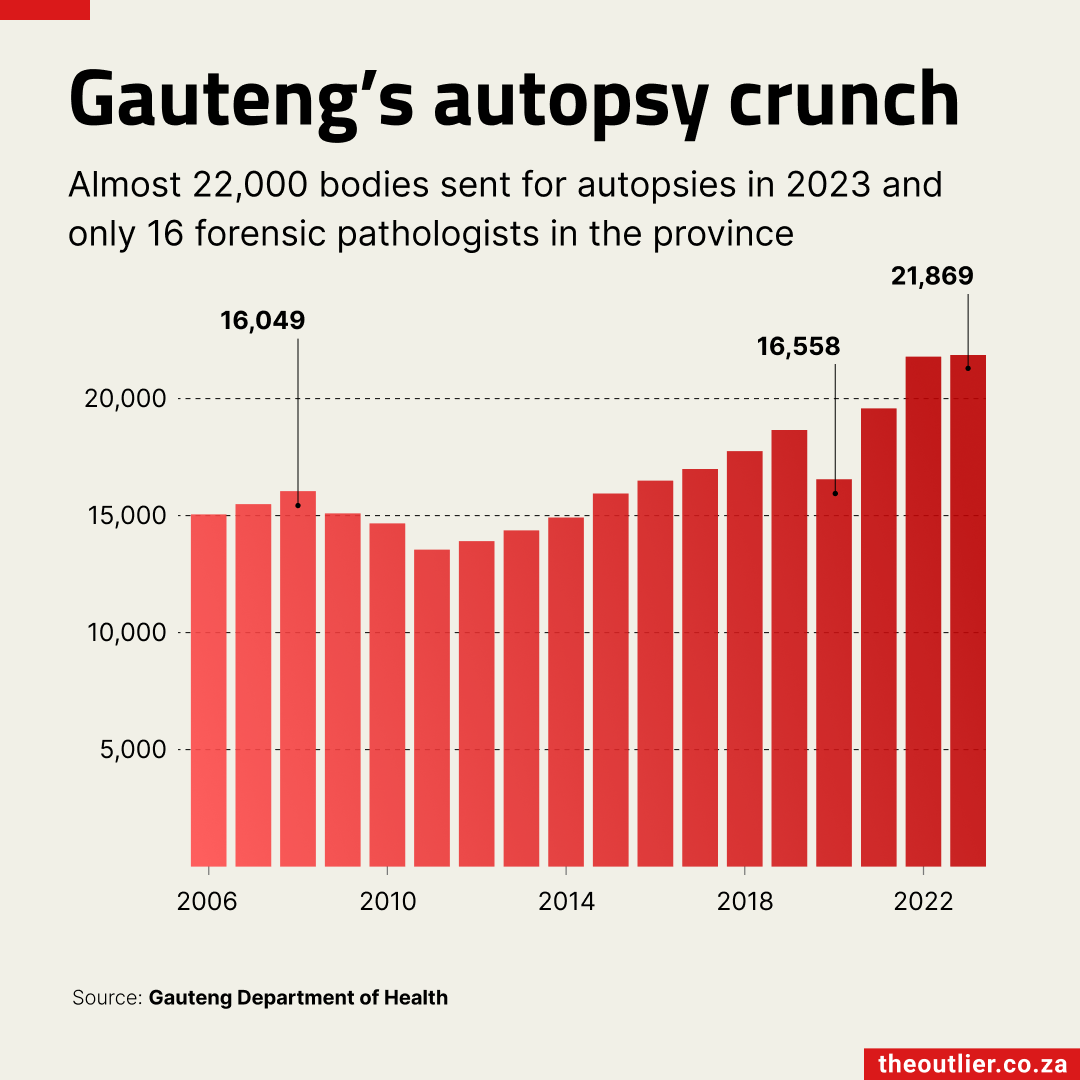
- SA has 50 forensic pathologists instead of the 330 it needs
- Gauteng has 16 forensic experts for a population of 15-million
- Almost 22,000 bodies were admitted for autopsies in 2023
A country ideally needs 6 forensic pathologists per million people, says specialist forensic pathologist and author Prof Ryan Blumenthal. Instead of the 330 South Africa should have, there were only about 50 working in the public sector in 2023.
Gauteng, which is home to 15-million people, has 16 forensic pathologists in public service, according to the provincial department of health. In 2023, almost 22,000 bodies – about 60 a day – were admitted for autopsies in the province. This is an increase of 45% from 2006, which is as far back as the data goes.
If they were to have performed all the necessary autopsies, the forensic pathologists would have had to assess 1,367 bodies each. Given that it takes about 3 hours per body (longer in more gruesome or complicated cases), each forensic pathologist would have had to work 12-hour shifts for 7 days a week to get their jobs done.

- 30% of women killed in 1,200 cases reported in the media were shot
- In 20% of the cases, women were stabbed to death
- Mass killings in the Eastern Cape pushed up shooting deaths in 2023
About 30% of the women killed in almost 1,200 cases in the past 5 years were shot, data collected from media reports shows. And almost 20% of the women in the female murder cases collected by The Outlier were stabbed to death.
The South Africa Police Service released its official crime statistics in February, which show that 3,880 women were murdered in South Africa in 2023. This is an increase of 24% over 2021’s 3,121 cases reported.
The official SAPS data only tracks the number of women killed. Data collected by The Outlier between 2018 and 2023 from reports in English-language media shows that shooting deaths have significantly risen in the Western Cape and KwaZulu-Natal regions in the past two years. There was a sharp increase in shootings recorded in the Eastern Cape last year, partly because of several mass killings in the province.
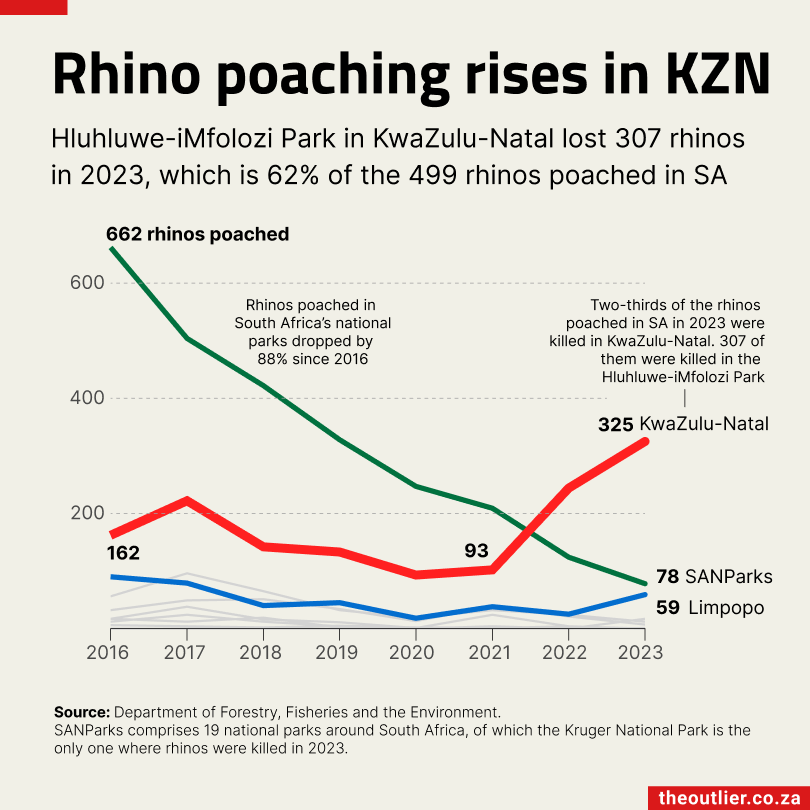
- 325 rhinos were killed in KwaZulu-Natal in 2023
- Nearly all of them were killed in the Hluhluwe-iMfolozi Park
- There has been a 219% increase in the number of rhinos poached in KZN since 2021
Rhino poaching in South Africa is better than it used to be, according to numbers released by the Department of Forestry, Fisheries and the Environment. 499 rhinos were killed in 2023, which is 51 more than in 2022, but still a long way off the 1,054 killed in 2016. But poaching in KwaZulu-Natal is rising at an alarming rate, especially in the Hluhluwe-iMfolozi Park, run by Ezemvelo KZN Wildlife.
Since 2021, which is roughly when the Covid pandemic ended, rhino poaching in KwaZulu-Natal has increased by 219%, from 93 rhinos to 325 in 2023. Sadly, 307 rhinos were killed in the Hluhluwe-iMfolozi Park alone, that’s 62% of the national total. Up to 2021, most rhinos were poached in areas run by SANParks, which manages 19 national parks around the country, the largest of which is the Kruger National Park. But poaching numbers in SANParks reserves have been decreasing steadily since 2016. In 2023 there were 78 rhinos killed, all of them in the Kruger Park. 81% of the rhinos were killed on state properties, 19% on privately owned reserves or farms.
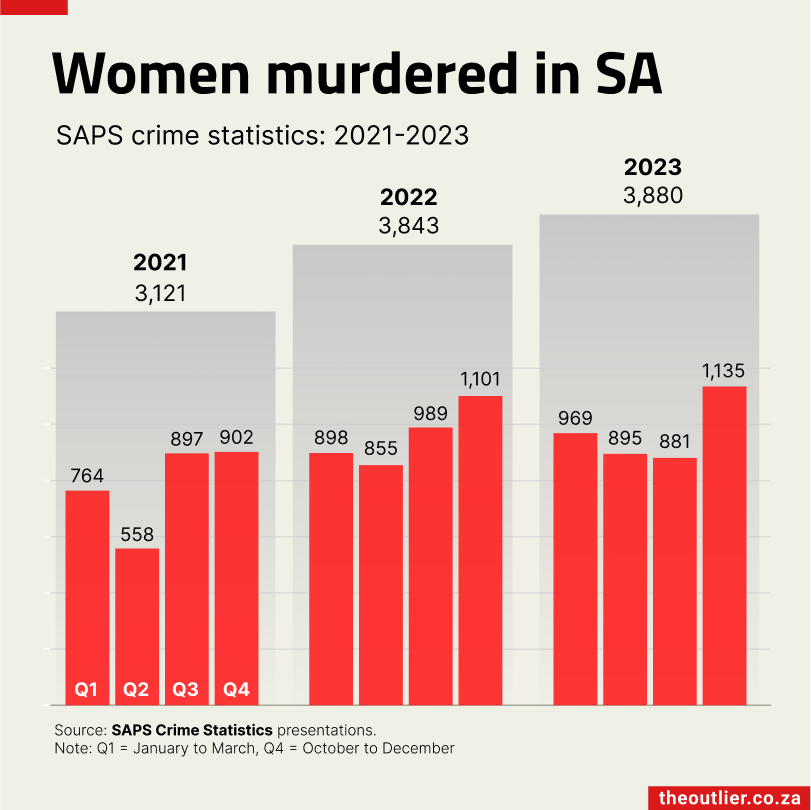
- Almost 11 women are murdered every day in South Africa
- 3,880 women were murdered in 2023, up from 3,121 in 2021
- Globally, 2022 recorded highest number of women killed in 20 years
The murder rate for women in South Africa has increased from 10 murders per 100,000 women in 2021 to 13 per 100,000 in 2023, according to the latest crime statistics released by the SA Police Service.
Put another way, 3,121 women were reported killed in 2021, which is an average of 8.6 women killed a day. In 2023, this increased to 3,380 women – or 10.6 women reported killed a day.
Female homicide is also increasing globally, with 2022 recording the highest number of women reported killed in the past 20 years, according to a UN Office on Drugs and Crime report. That same year, Africa recorded the highest number of female victims since 2013.
The majority of intentional homicides of women and girls are gender-related, the report states. These can be driven by social norms about masculinity and male entitlement, but there often isn’t enough information to identify what motivated them.
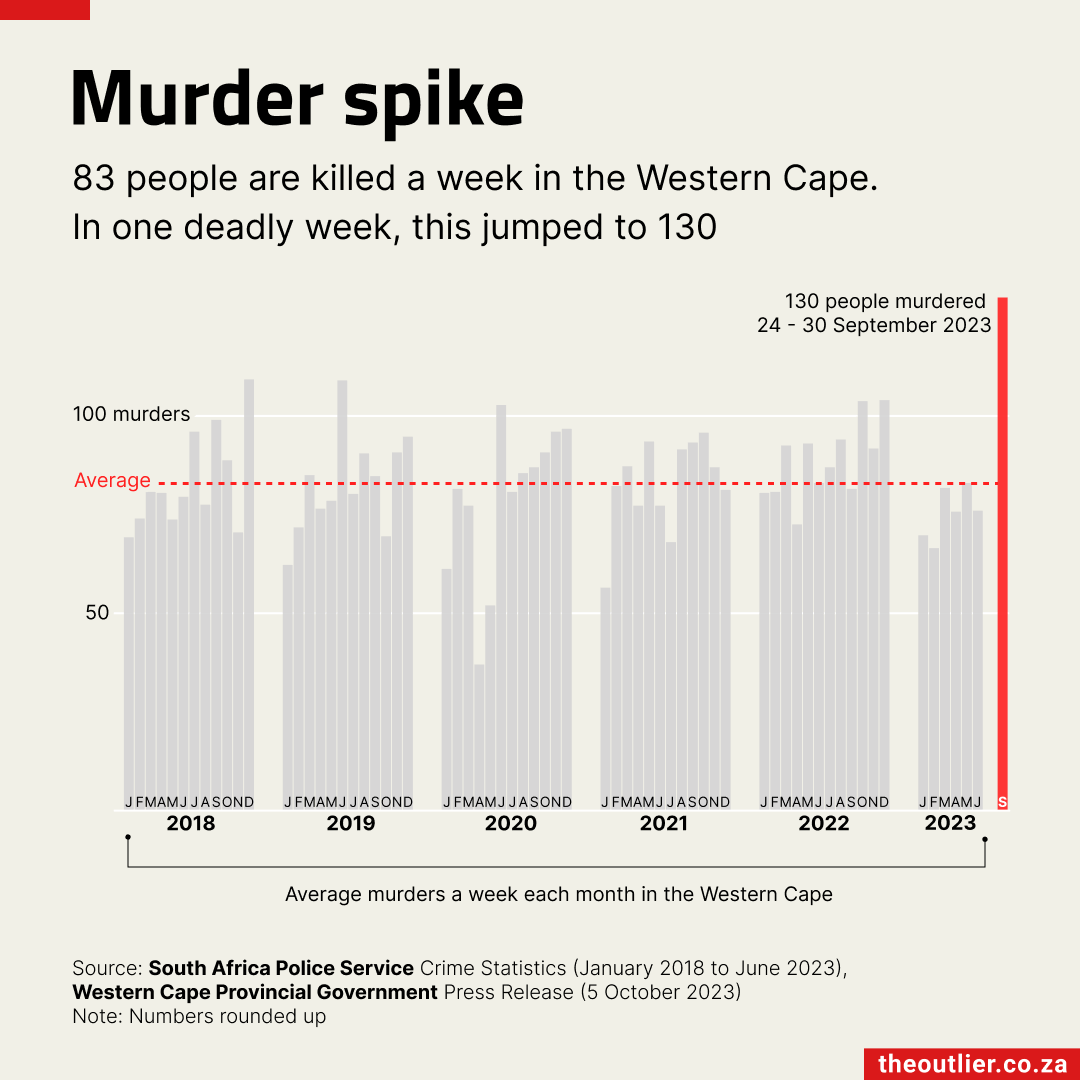
- An average of 83 people are murdered every week in the Western Cape
- 130 people were killed in one week in September 2023
The Western Cape experienced one of its deadliest weeks at the end of September 2023 when 130 people were murdered. This is higher than any other week in the past 5 years, according to police records that The Outlier has been tracking. On average, 83 people are murdered in the province in a week – that's the equivalent of almost 12 people a day. Between 24 and 30 September 2023, Gugulethu recorded the highest number of homicides (13), including 2 incidents in which 10 people were killed. Gugulethu has a police-to-population ratio of 1:874, while the national ratio is 1:413, according to figures from the Western Cape government.
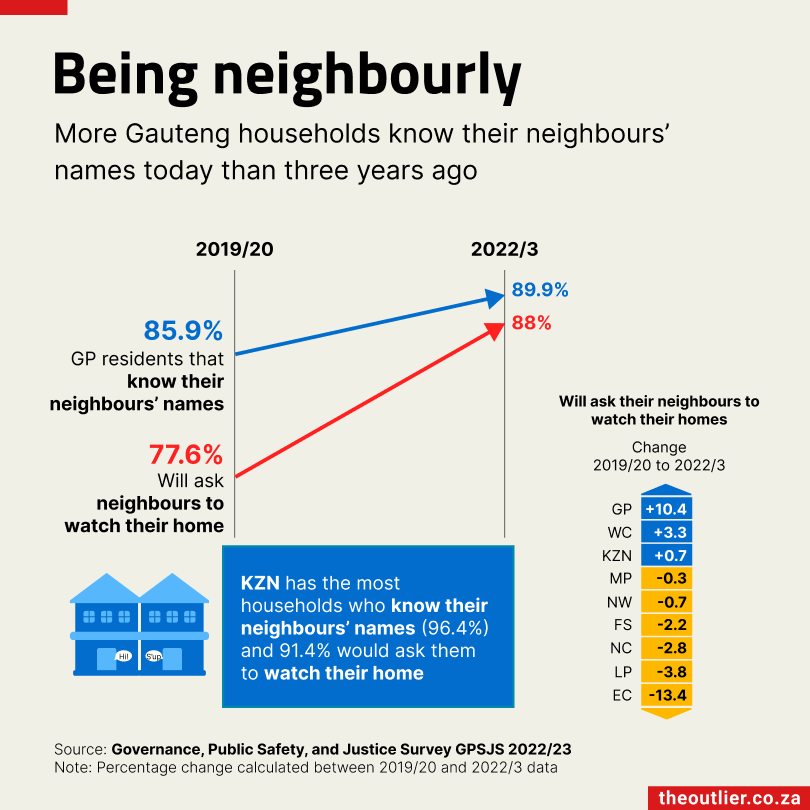
- More South Africans are getting to know their neighbours’ names compared with 3 years ago
- Neighbours are more willing to look out for each other when they know each other
- Residents in Gauteng are more likely to ask their neighbours to watch over their homes in 2022/3 than they were in 2019/20
Gautengers are getting friendlier, according to a new survey. Almost 90% now know their neighbours' names and they’re also much more willing (88%) to ask their neighbours to watch their homes than they were three years ago (77.6%). The Statistics South Africa Governance, Public Safety and Justice survey measures the levels of crime experienced by households and individuals. It shows that people are more willing to look out for each other when there are strong community bonds. They’re more likely to report suspicious activity on a neighbour's property and are more willing to watch over each other’s children or homes.
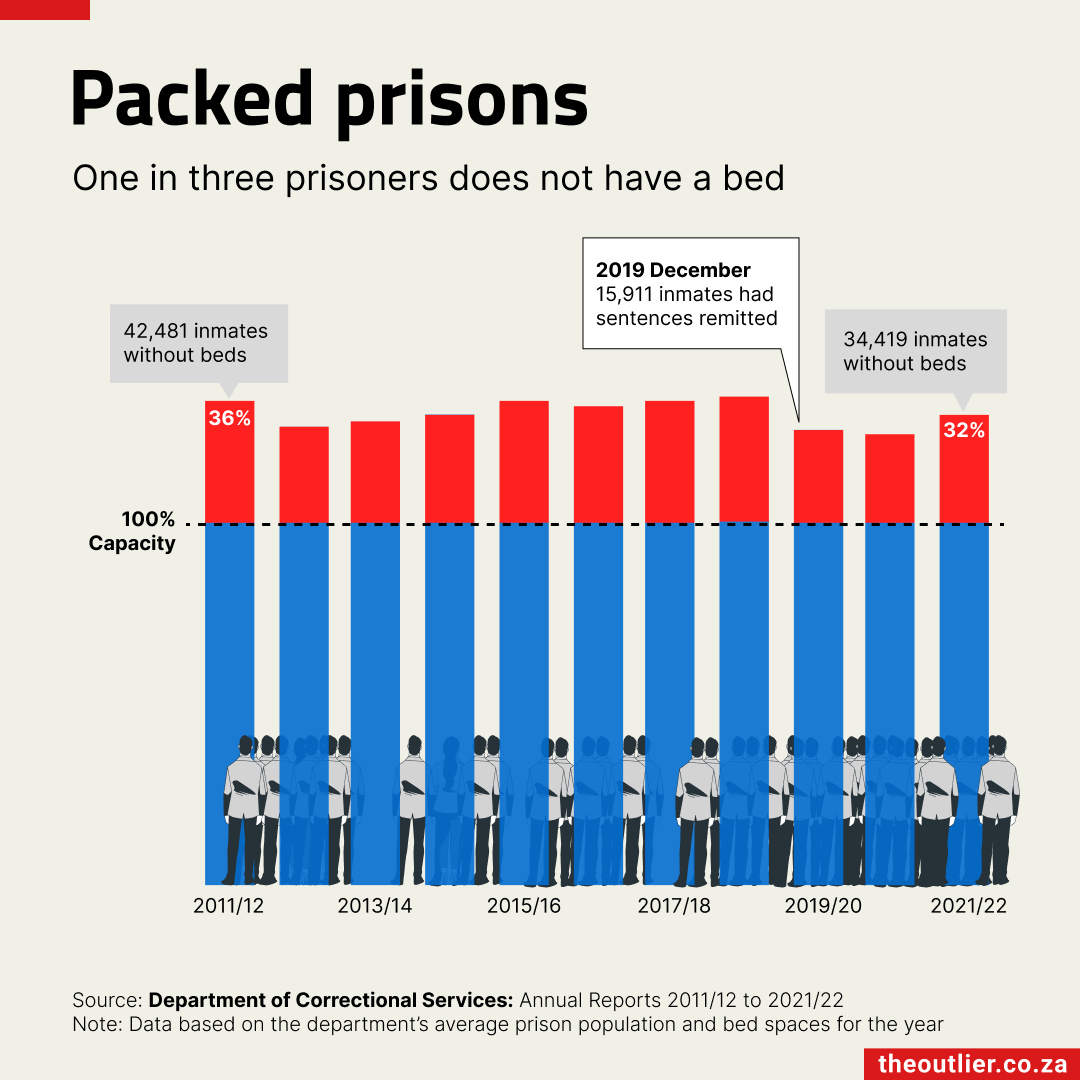
- South Africa’s prisons have been over capacity for the past decade
- On average, one in three prisoners does not have a bed
- About one-third of the 143,000 people in prison in 2021/2 were unsentenced
The sentences of almost 9,500 non-violent offenders, including former president Jacob Zuma, were remitted on 11 August. This is the third time Cyril Ramaphosa will release prisoners in an attempt to ease overcrowding in South Africa’s 243 prisons. For the past 10 years, an average of one in three prisoners has not had a bed. About one-third of the 143,000 people in prison in 2021/2 were waiting for their cases to be finalised.
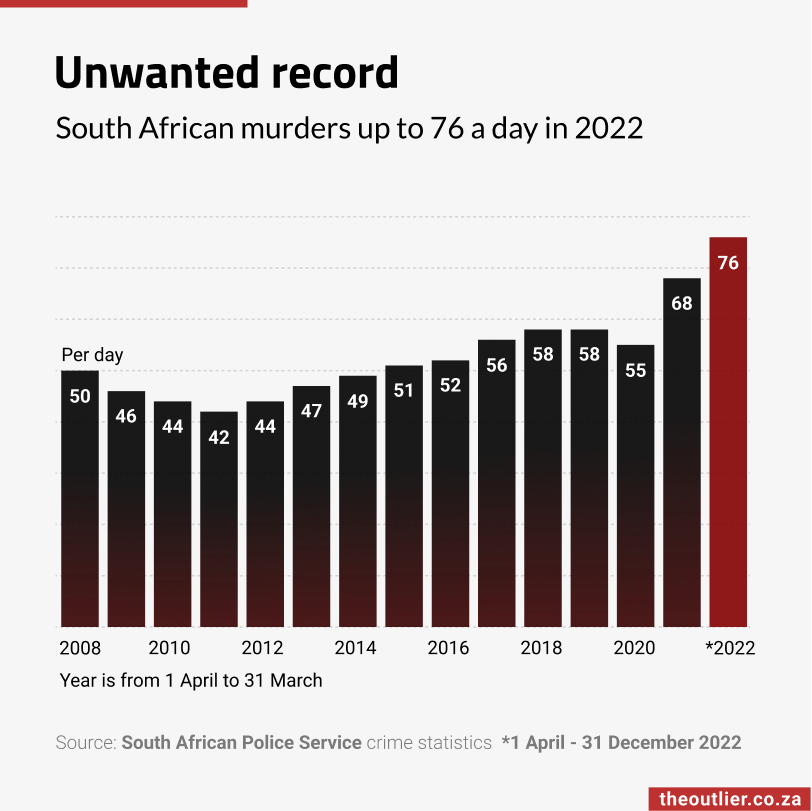
An average of 76 people were murdered a day in South Africa last year, more than three murders every hour.
